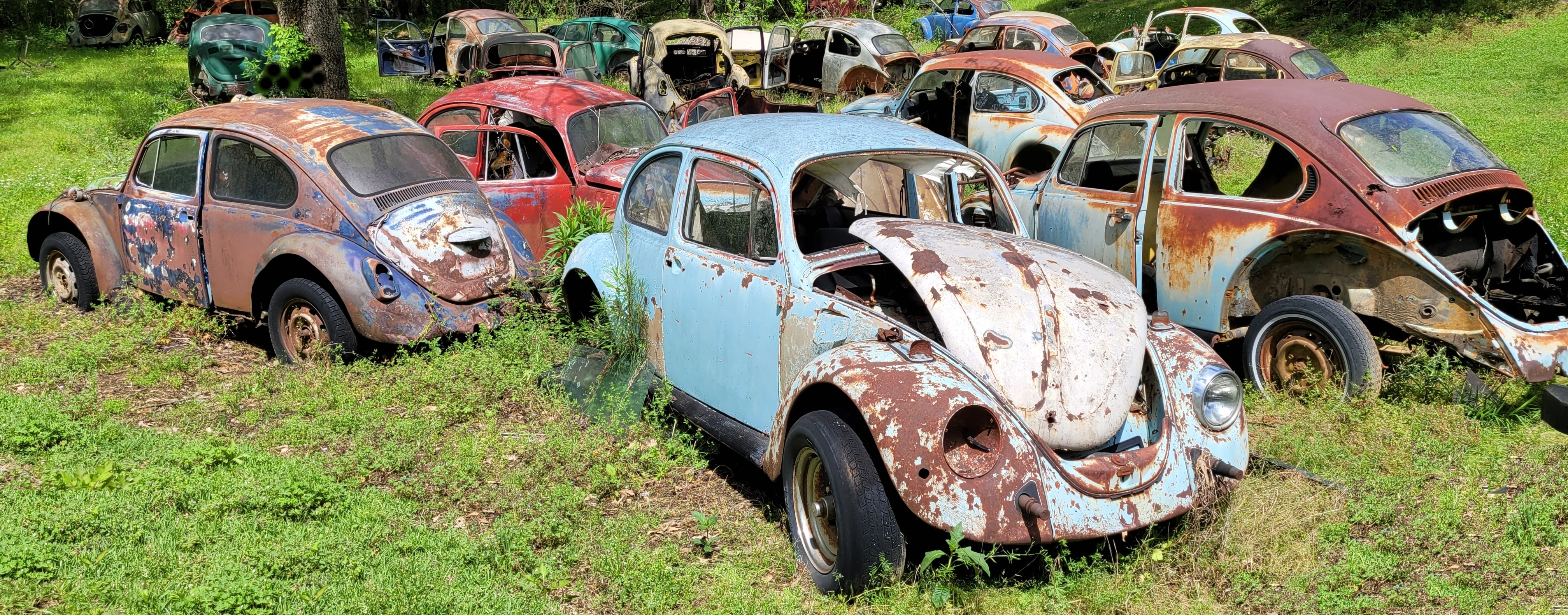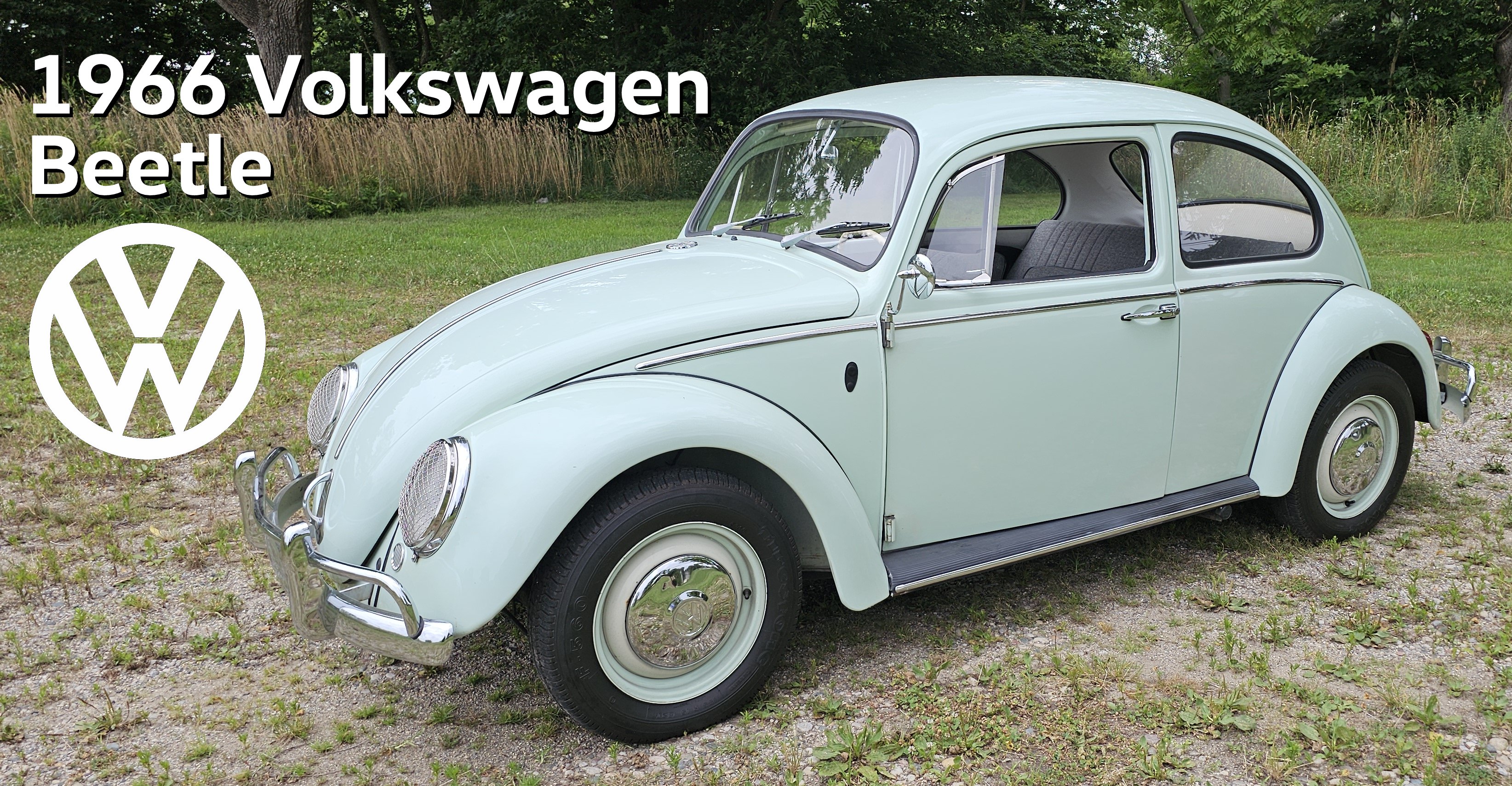
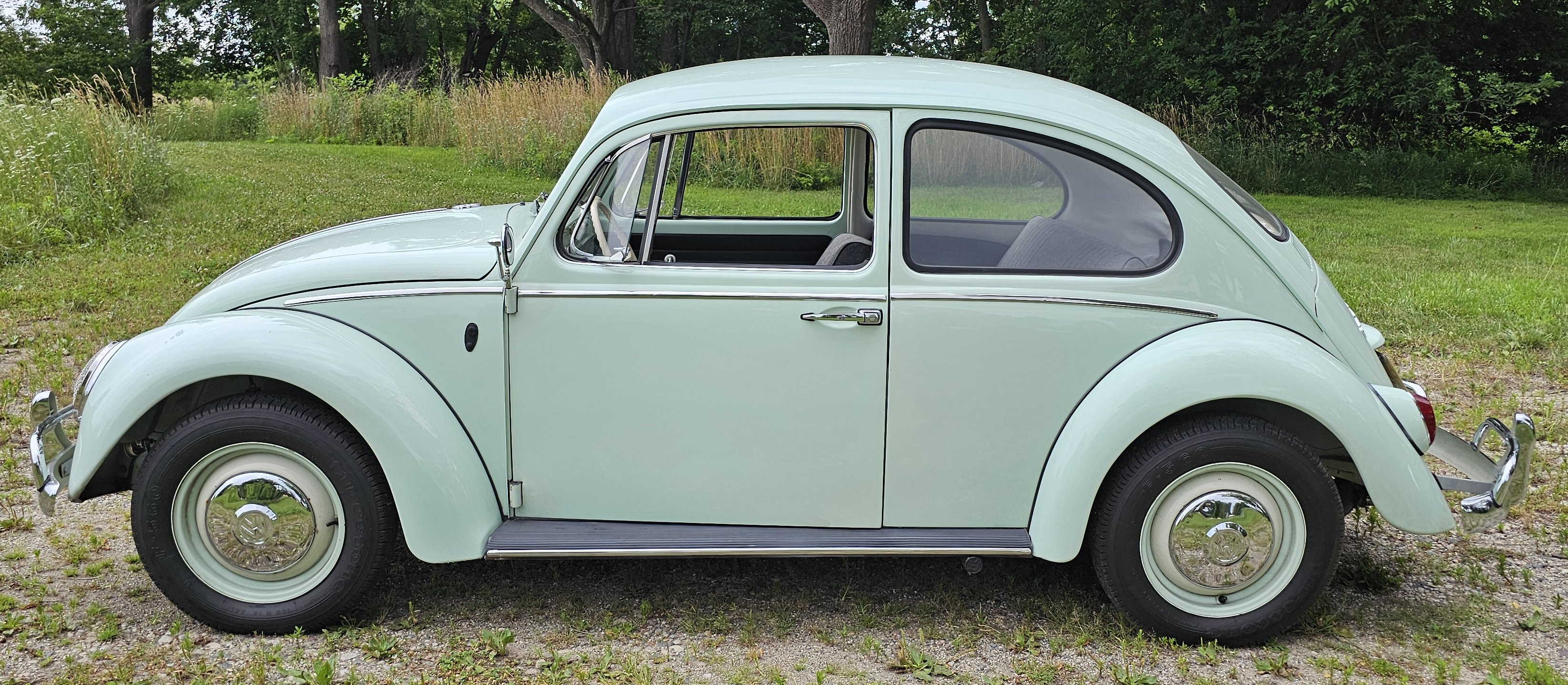
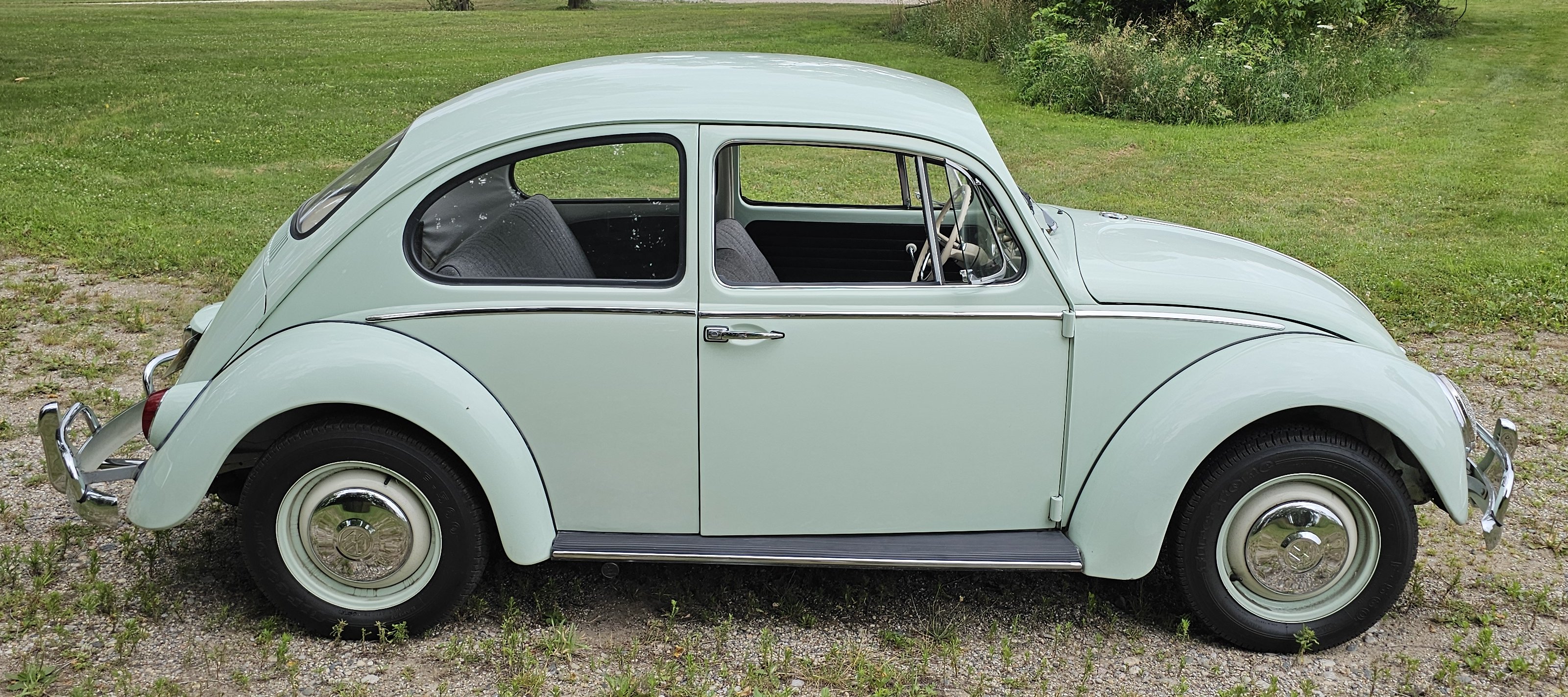
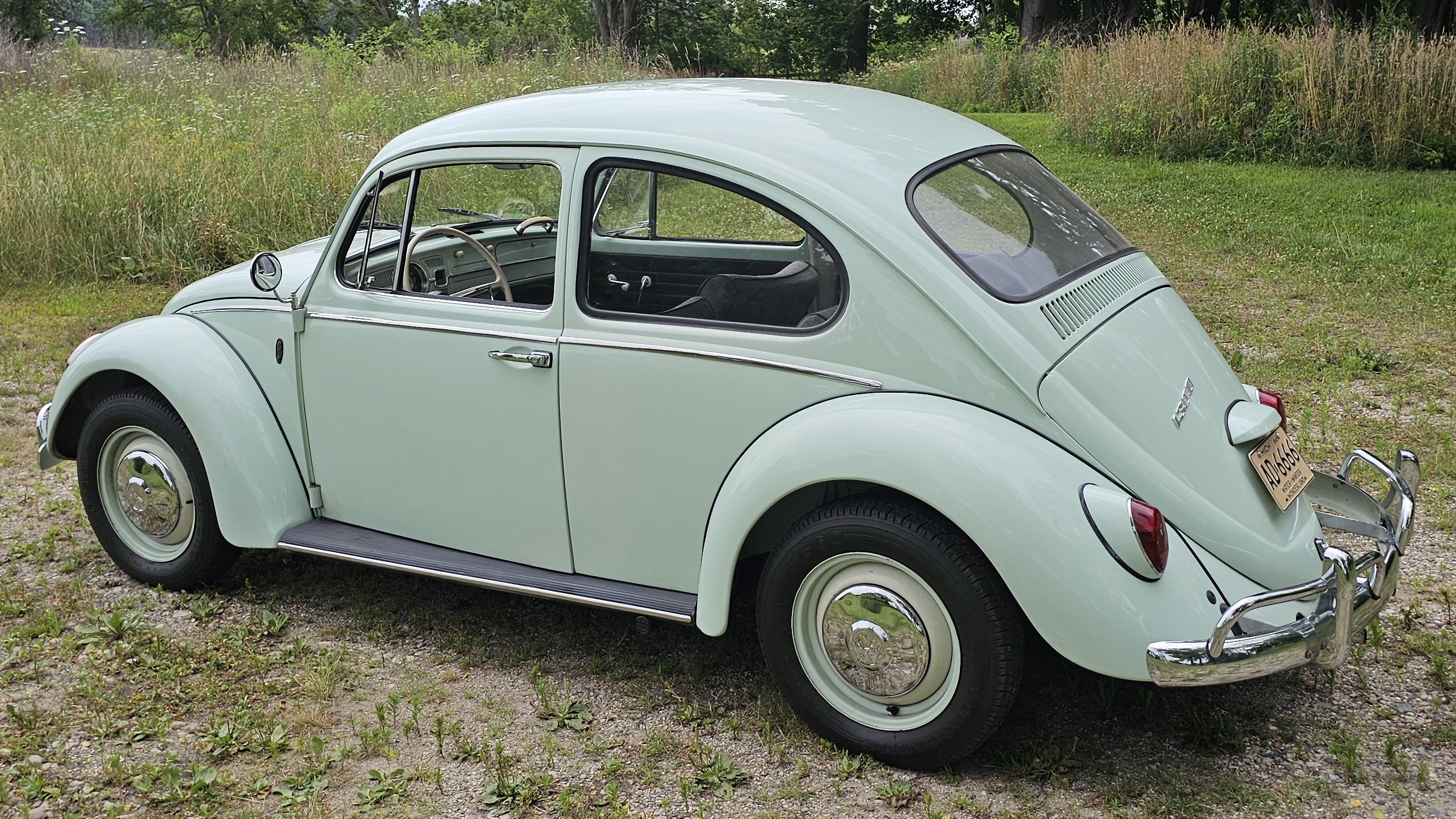
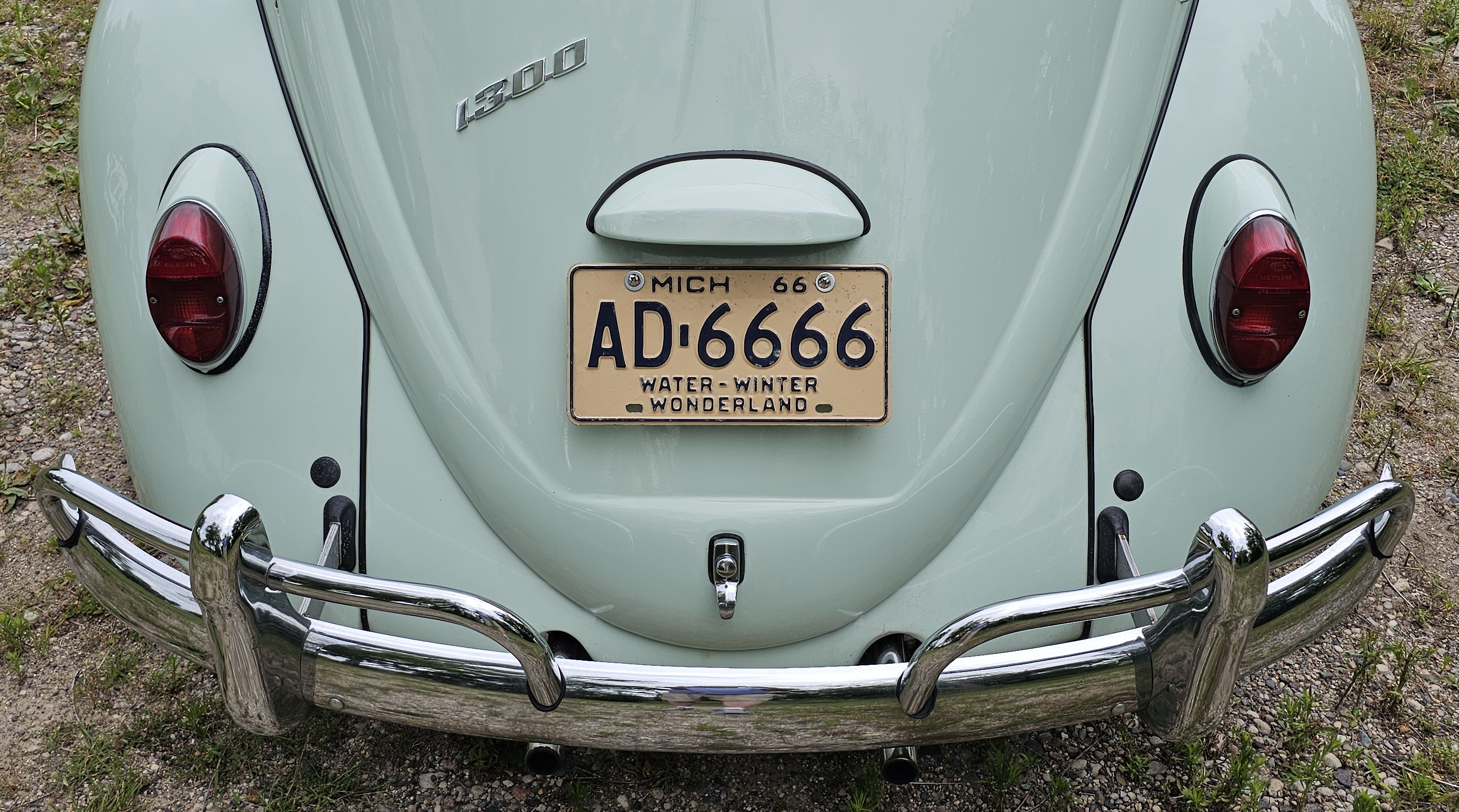
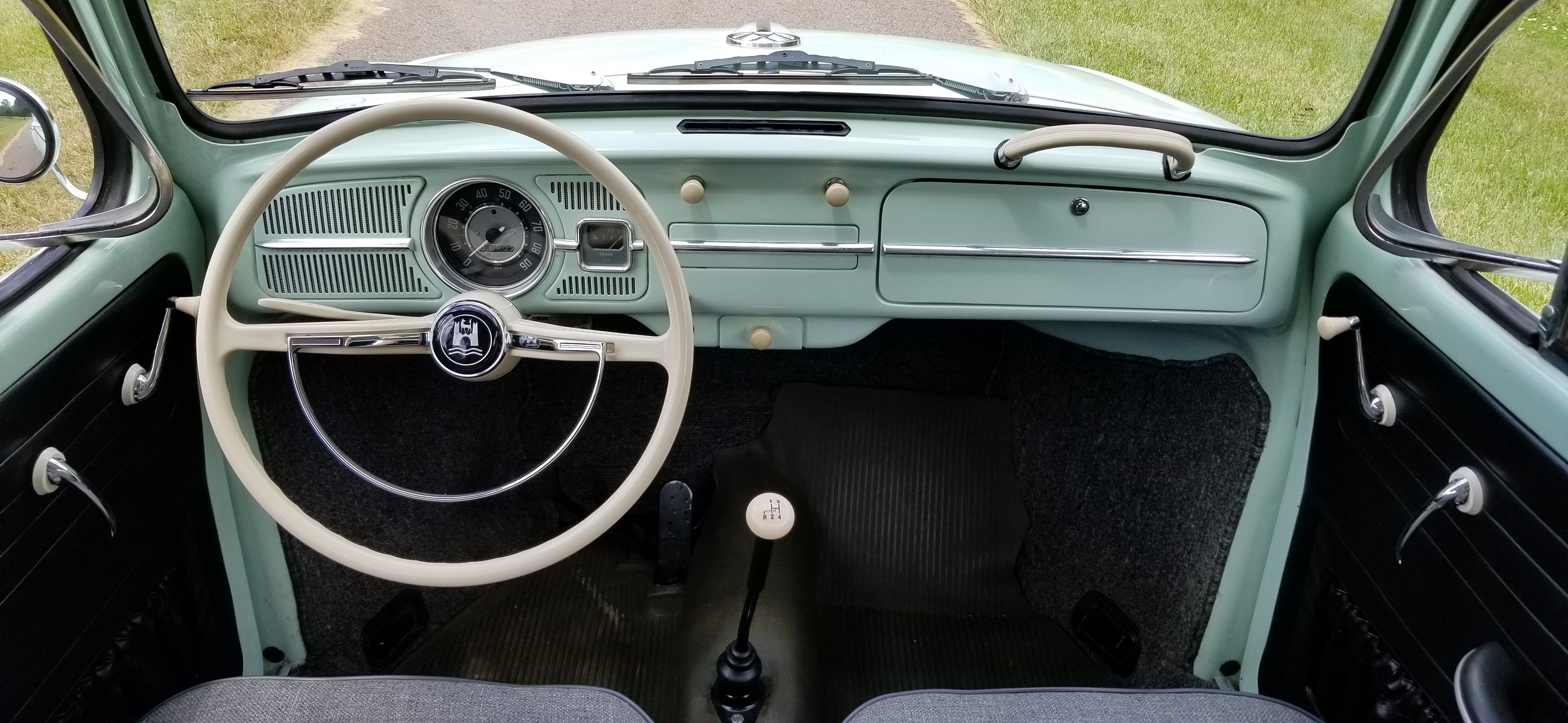
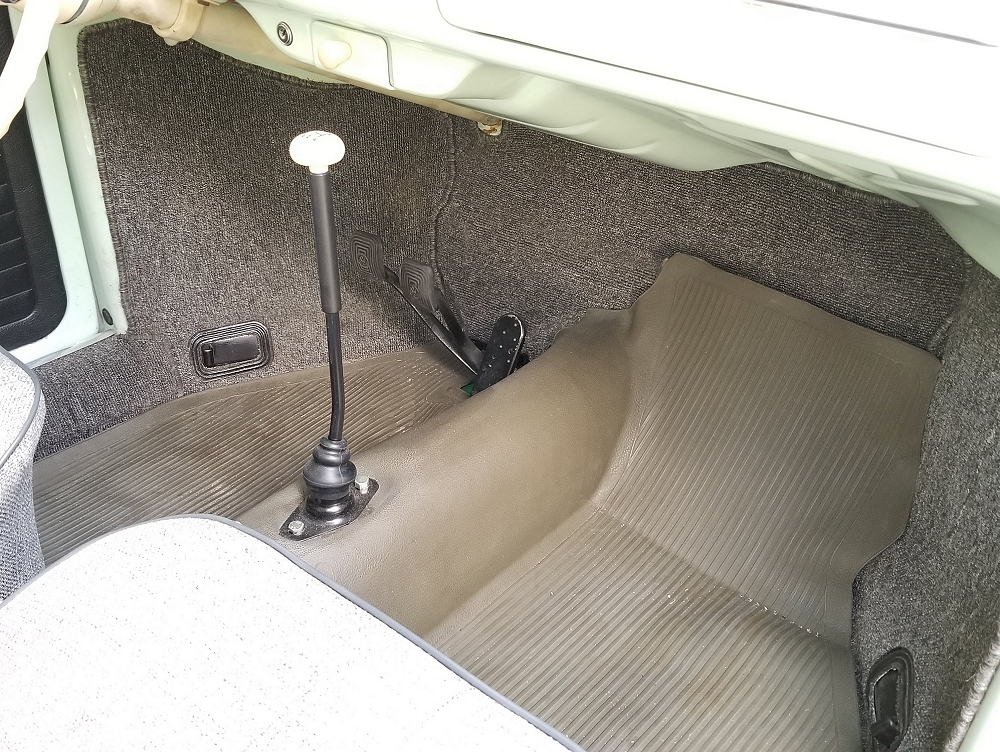
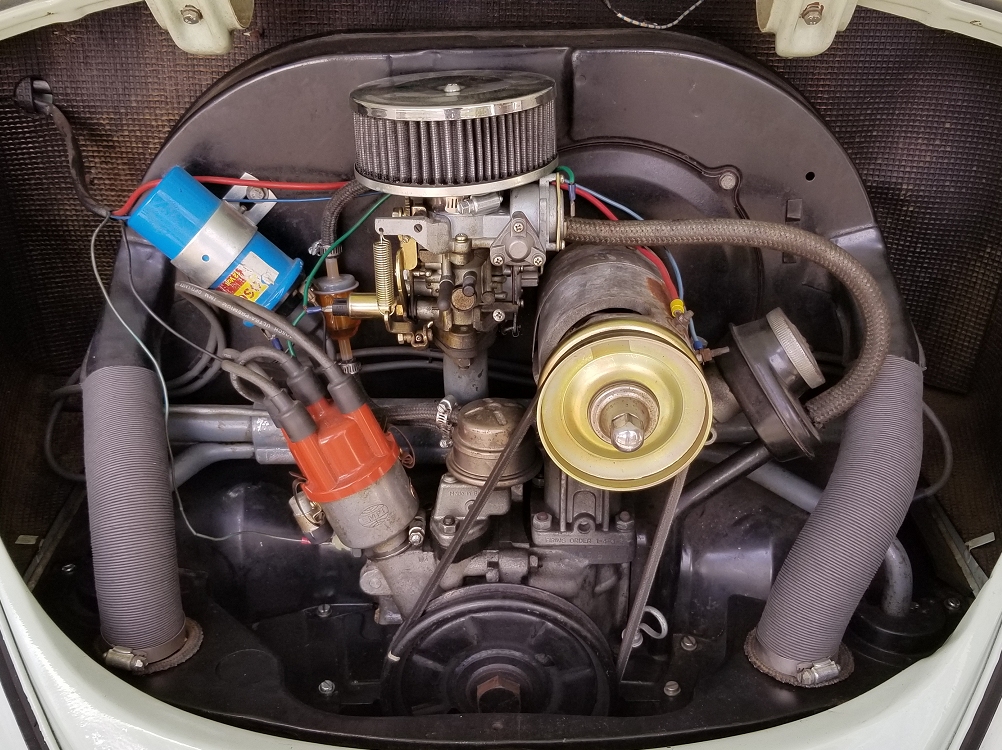
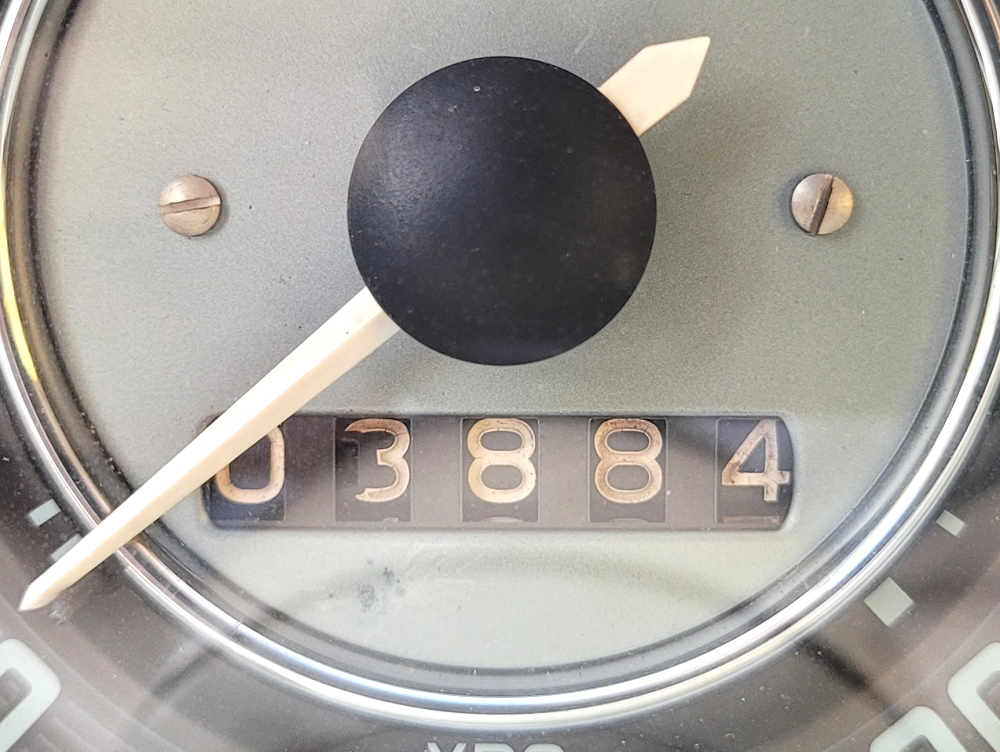


|
Available to US buyers only. Car is located in Lansing MI. My email: 1855mac@gmail.com |
My email: 1855mac@gmail.com
My video / History of VW Beetle / 1966 VW Beetles only / Volkswagen USA











|
Available to US buyers only. Car is located in Lansing MI. My email: 1855mac@gmail.com |
My email: 1855mac@gmail.com
My video / History of VW Beetle / 1966 VW Beetles only / Volkswagen USA

My 1966 Beetle
• 1,080,165 units built in 1966 production year
• 1966 was the only year the "1300" engine was offered
• Maximum output: 50hp at 4600 RPM
• Maximum and cruising speed: Officially 74mph (seriously?!)
• Acceleration: 0-60mph in 23 seconds (no whiplash in this car!)
• Fuel tank: 10.6 US gallons
• Fuel efficiency: 28.5 miles per gallon
• Oil capacity: 2.65 US quarts
• Battery: 6-volt (my car was later changed to a 12-volt system)
• 13.4 ft long, 5 ft wide, just under 5 ft tall, just under 8 ft wheelbase, 36 ft turning circle
• Curb weight: 1,672 lbs
• Tires: 5.6 x 15 tubeless (recommended air pressure 18 PSI Front, 28 PSI Rear)
• 1966 price tag: $1,574
• Bumper-to-bumper restoration in 2006.
• VIN: My car has a 9-digit Vehicle Identification Number, issued in Germany at the factory
• When I bought this car (Oct 2016), the odometer was 1,513 miles--- re-set when the engine was rebuilt.
• When my car came off the line in Dec 1965 in Germany, it was painted Pearl White with Pigalle (a dark red) leatherette upholstery. When my car was restored in 2006, the owner chose Bahama Blue, another official VW Beetle color in 1966. He used Sherwin-Williams Automotive paint #4961215. Pearl White and Bahama Blue are both original VW colors for 1966 (see 1966 chart below). My car often appears powder blue in photos, but it is definitely a pale green. For this reason, I prefer photographing my car under overcast skies.
• A list of changes, improvements, and modifications I have made (or more accurately: have HAD made) to my 1966 Beetle appears later on this page.
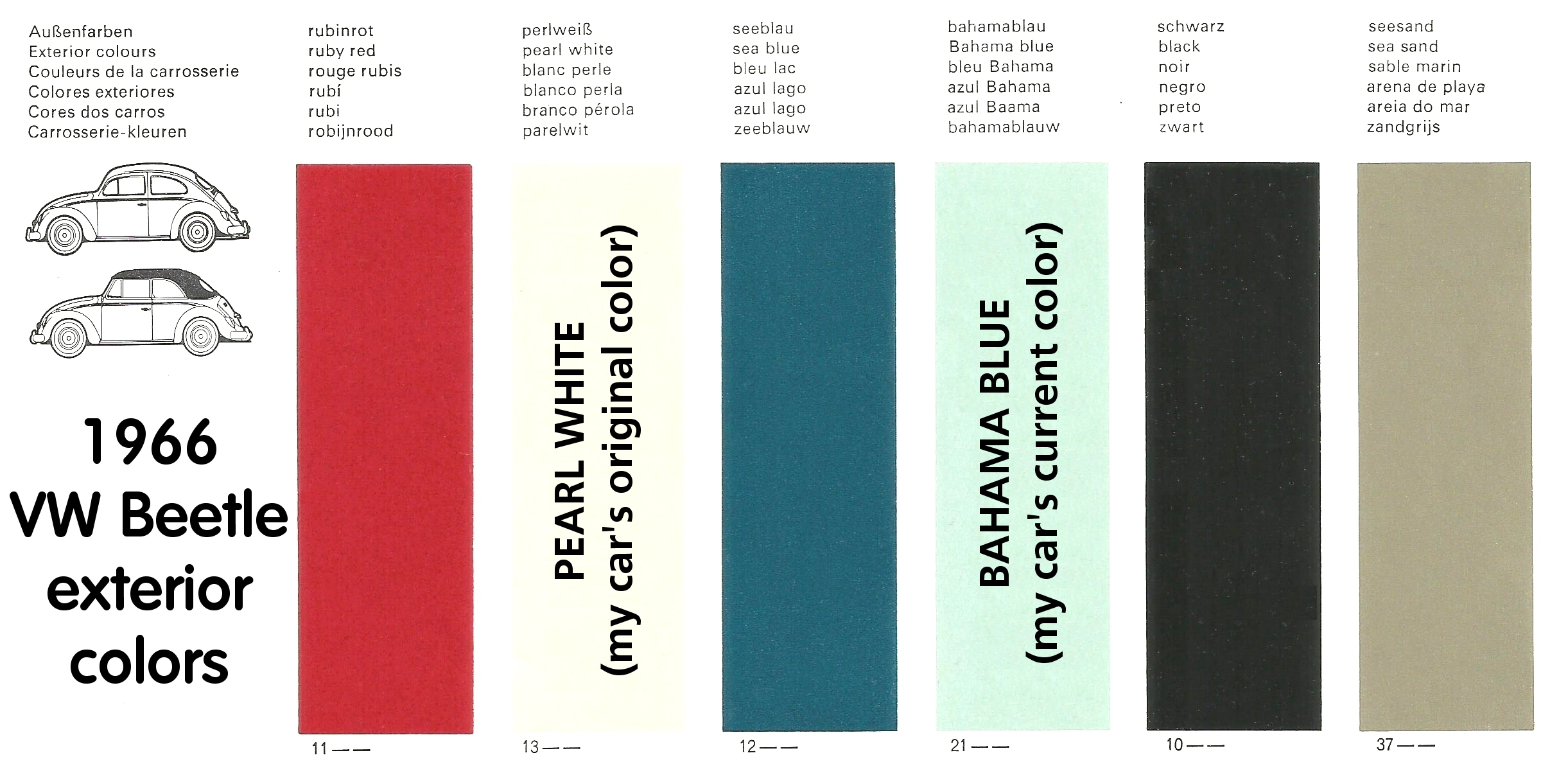
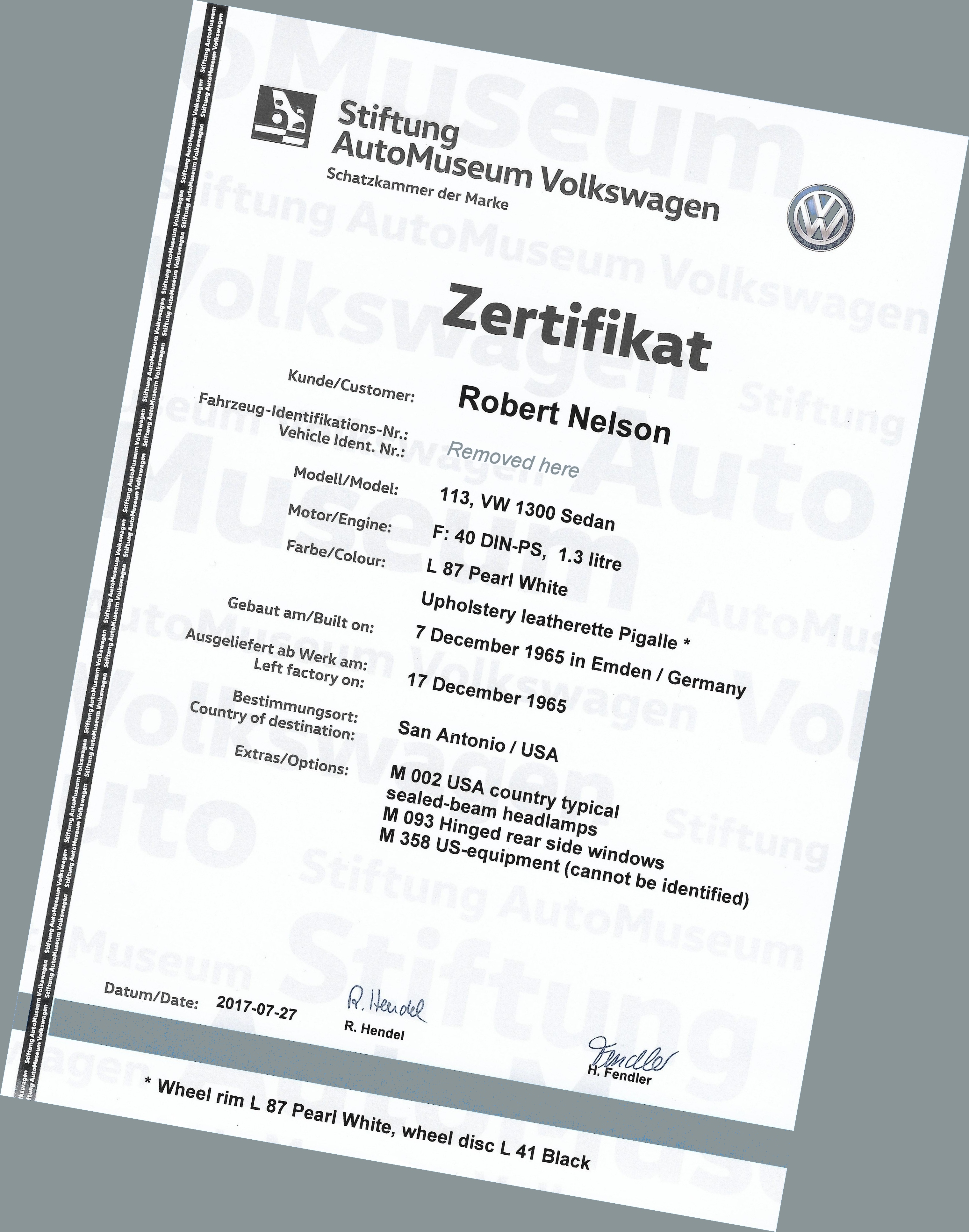
|
Birth Certificate - I acquired my car's "Birth Certificate" from the Stiftung VW AutoMuseum in Wolfsburg, Germany. It confirms that the engine in my car is not the original (it was probably changed when it was restored in 2006). The original color of my car was Pearl White with Pigalle (a dark red) leatherette upholstery; Pearl White wheel rims with Black wheel discs. My car was built 12/7/1965 in Emden, Germany; it left the factory on 12/17/1965; then exported to San Antonio TX. |

1966 VW Beetle
• Production: 1,080,165 units built, all in Germany (US sales: 296,624 sedans; 5,799 convertibles)
• US sticker price: $1,574 sedan; $2,061 convertible
• Chassis numbers: 116 543 112 to 117 422 503
• Engine numbers: D0 053 049 to D0 120 750
• Horsepower increased from 40 to 50
• Displacement increased to 1300cc ("1300" emblem added to engine lid)
• Ventilating slots added to wheels
• Flat hubcaps
• Four-way emergency flasher system added
• Headlight dimmer switch added to turn signal switch
• Center defroster outlet added to dash
• Semi-circular horn ring added
• Suspension improved with better torsion bars and shocks
• Front seats equipped with safety locks
• Ball joint front suspension introduced

Changes, Improvements, Modifications
Things I've done to my car since I bought it in October 2016. Many of these were completed with the excellent help of my buddy Jerry, and are so designated with an asterisk.
2016
• Purchased car from a private owner in Atlanta GA. Had it shipped to Michigan. The odometer showed 1,513 miles (miles driven since the car was restored in 2006).
• Added adhesive-backed 3½" convex mirror to the driver's side mirror. (Convex mirrors have saved me many times. I do not mind trading a little historical authenticity for a large amount of safety.)
• Removed antenna and covered two existing holes with rubber gasket from the antenna assembly. (No radio, so why keep the antenna?) Used two nylon automotive inserts to secure the gasket.
• Replaced both headlights with Wagner halogen lamps. Replaced both turn indicator bulbs located within headlamp assemblies.
• *Removed both door panels, lubricated window assemblies; adjusted internal latch mechanism so passenger door could be opened from inside
• *Removed and serviced windshield wiper motor assembly so that both wipers now work (but still very poorly). Discovered that windshield washer was not hooked up to spare tire. I will leave it that way.
• Replaced both exterior door handles; *Jerry customized interior mechanism of driver side door handle to improve operation
• Replaced both interior door handles, both interior window cranks, and the four interior escutcheons
• Replaced weather seals on both doors
• Replaced original cardboard glove box with a black plastic upgrade; replaced both rubber bumpers inside glove box.
• Replaced both defrost hoses, though I never use them.
• Replaced all 56 interior clips and boots holding both door panels in place
• Replaced VW logo hood (bonnet) emblem
• Replaced both hinge pins in driver door (thanks to John at State of Mind Customs)
• Trimmed driver side exterior door molding 3/8" for better fit
• *Replaced driver door jam light switch and rubber gasket
• *Replaced both front bumper bracket rubber seals; adjusted front bumper brackets to better accommodate the bracket rubber seals, though they still do not fit as they should. Oh well.
• *Replaced several broken retainer clips that hold hubcabs to wheels (5 per wheel)
• *Tightened both rear axleshaft nuts (36mm socket) to prevent any possible wobble; replaced both cotter pins
• Replaced Wolfsburg emblem on steering wheel
• My thanks to members of the Michigan Vintage Volkswagen Club (though they no longer maintain a website!) who told me that my front turn indicators are probably a custom design. A previous owner probably removed the turn indicators from on top of the fenders (where they should be for a 1966 VW Beetle Sedan) and wired the running lights (located within the headlight assemblies) as turn indicators. I would never choose to customize my car this way, but since it is already done by a previous owner, I will leave them as is.
2017
• *Replaced generator belt. Used 6 of 10 shims. Will remove some shims after a few hundred miles to reduce slack that will naturally develop.
• Added hose clamps to ends of gas line after leak was observed. Leak solved.
• Had all three seats reupholstered with "charcoal tweed" cloth, replacing the Navy blue vinyl.
• Replaced air filter element.
• Replaced all four shocks. (Thanks to Ballard M. at Williams Volkswagen.) It now rides smoother and a bit higher than before. I don't like the lowered "Southern California" look. I much prefer a "stock" Beetle, and these new shocks get it there nicely!
2018
• Changed license plate to authentic 1966 (black on cream) Michigan license plate "AD6666," perfect for a 1966 car!
• *When left rear brake locked up for no apparent reason, examined "star wheels" on brake adjusters. Found retaining clips that inhibit star wheels from rotating were missing from left rear brake. Wired star wheel to prevent unintentional rotation. Also, replaced right rear brake drum and both front brake drums. (Note: I would later replace the right front brake drum with one made in Germany when one of the lug nuts in this Italian version stripped the threads.)
• *Replaced all front-end ball joints, and mounts for stabilizer bar. (Learned a LOT from this project! The stabilizer bar mounts finally went in but with great difficulty, and the right front fender has a hardly noticeable wrinkle under its lip. So we think the car may have been in some low-speed crash prior to my purchase.)
• Discovered Westley's Black Magic "Bleche-Wite" tire cleaner. Excellent for cleaning white walls. (Would later switch to black walls, so this product is no longer a factor.)
• After experiencing some clutch slippage, I took my car to All Import Auto Care for a complete "once over." Denny and his crew repaired/replaced the clutch, engine and transmission mounts, transmission fluid, both axle boots, valve cover gaskets, fuel line from tank to engine, fuel filters, oil pressure switch, generator pulley, fan belt, accelerator tube, carb spring, muffler, muffler gaskets, engine cooling hoses, front wheel cylinder, refill brake fluid. A lot of work ($1,912), but wow--- she drives, rides, and sounds like 1966 again! Truly, a new car! I also learned that I was running her with too much tire pressure. Should be 18 PSI Front, 28 PSI Rear. (Update: Due to the impact of Covid19 on business, Denny permanently closed his doors at All Import. Bummer. He provided such great service for so many years.)
• Replaced Wolfsburg moon chrome hubcaps with stock-design chrome hubcaps (embossed VW logo at center)
• Engine kept dying out at Stop Lights. Removed Idle screw, blew out Idle port, reinstalled screw all the way until it gently stopped, then backed it out six half-turns. Idles beautifully now.
• *At a stop light, slipped it into Neutral, waited for light to turn. But then could not find any gear but Third. Limped home in Third. Adjusted clutch cable freeplay. Much better. (Would later replace the entire clutch cable which solved this issue!)
• *My driver's seat made a "clunk" whenever I got in the car. It started when I had the seats re-upholstered. Found that the "outside" rail on which the seat rides had bowed slightly, so when I got in, the seat would "clunk" off that rail. A heavy screwdriver helped bend the rail back into place and eliminate the "clunk."
• My neighbor Jon fabricated a 5" aluminum extension to the existing shifter, making shifting way easier.
2020
• *Replaced steering wheel and horn ring.
• Installed after-market mesh headlight screens; replaced both horn grills.
• Replaced horn. *Replaced both front wheel cylinders.
• *Replaced right front Italian-made brake drum with one made in Germany.
• *Replaced generator.
2021
• Replaced all five white wall tires with new Firestone F560 155R15 black walls from Coker Tire Co. 20 PSI front; 30 PSI rear; 55 foot pounds of torque
• *Replaced all retainer clips that hold hubcabs to wheels (5 per wheel x 5 wheels)
• Replaced dashboard grab bar above glove box
2022
• *Replaced carburetor
• *Replaced clutch cable (original cable finally broke); replaced sound deadening material under front seat floor mats
• Replaced brake boot and both heater knobs on center console
• Replaced battery
2023
• *Replaced points and condenser; adjusted timing. Replaced valve cover gaskets. Replaced oil (2.6 US quarts of O'Reilly straight SAE 30 Heavy Duty motor oil) at 3,902 miles.
• Engine developed a sputtering, as if carburetor was being starved of good gas, despite always using Shell's highest grade octane. Suspecting it was simply last year's old gas causing the problem, added 12 oz bottle of gas antifreeze (dry gas) to the tank.
• *Replaced wheel bearing seals in both front wheels. Torqued lugnuts to 80 Nm (Newton-metres).
• *Replaced all four spark plugs (NGK BR6HS #3922) at 4,090 miles
2024
• *Replaced master brake light switch
• *Installed "clutch pedal shaft upgrade" (from ClassicBugParts.com) when clutch cable unexplicably detached from hook at end of original clutch pedal
• Replaced oil (2.6 US quarts of O'Reilly straight SAE 30 Heavy Duty motor oil) at 4,250 miles. Note: Drain plug does not require a crush washer; has a brass washer permanently pressed into bolt.
• Filled reservoir with Dot3 brake fluid. There is no "fill to here" line so I filled to the top of the metal retaining strap.
• *Replaced all four spark plugs (NGK BR6HS #3922) when I learned that I had been starting the car wrong, resulting in me inadvertently fouling up the spark plugs.
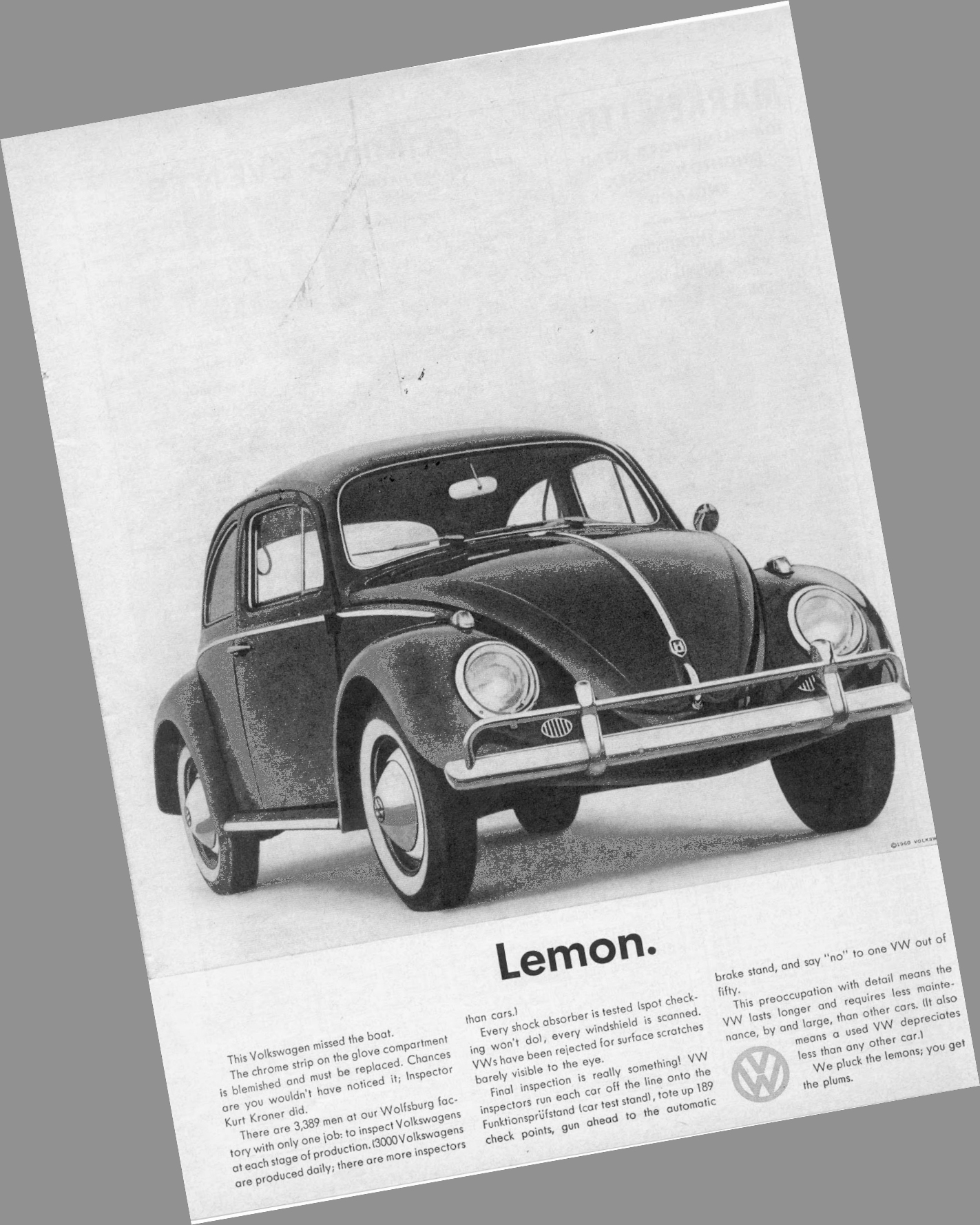
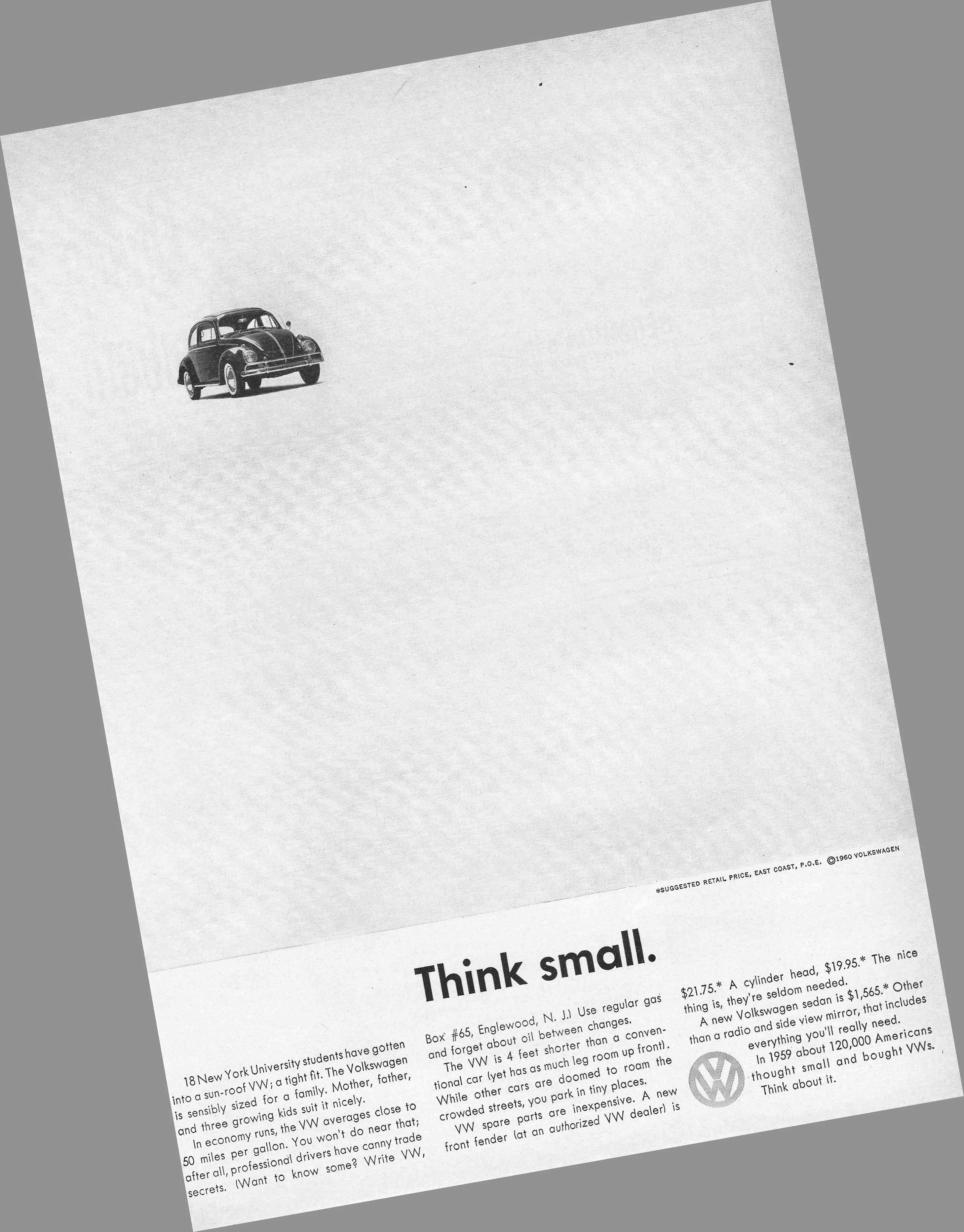
The first ad of the "Think Small" campaign was called "Lemon." It explained how 3,389 inspectors meticulously examine each VW Beetle before it is shipped to the USA. But this Beetle "missed the boat" due to a blemish near the glovebox. "We pluck the lemons, you get the plums."
If you loved the "Think Small" print campaign, you would love the excellent coffee table book Remember Those Great Volkswagen Ads by Alfredo Marcantonio, David Abbott, and John O'Driscoll.
My favorite VW TV ads: 1949 Auto Show and Funeral Procession

Milestones
|
I am not denying, ignoring, or in any way minimizing the absolute evil of Adolf Hitler and his regime. |
1933 - Dr. Ferdinand Porsche (1875-1951) draws first sketches of a simple little car that common citizens could own and enjoy.
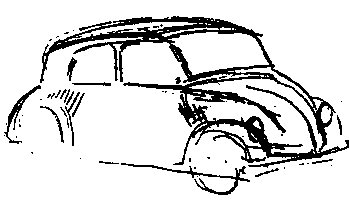
1934 - Nazi leader Adolf Hitler commissions Porsche to develop the KdF-Wagen ("Kraft durch Freude" or "Strength through joy"), forerunner of the VW Beetle.
1936 - At Berlin Auto Show, Hitler announces that Porsche will design a Volkswagen ("People's Car"). Porsche promises Hitler he will produce three prototypes by year's end.
1937 - First road test of prototypes.
1938 - Thirty prototypes (called Series 30) built
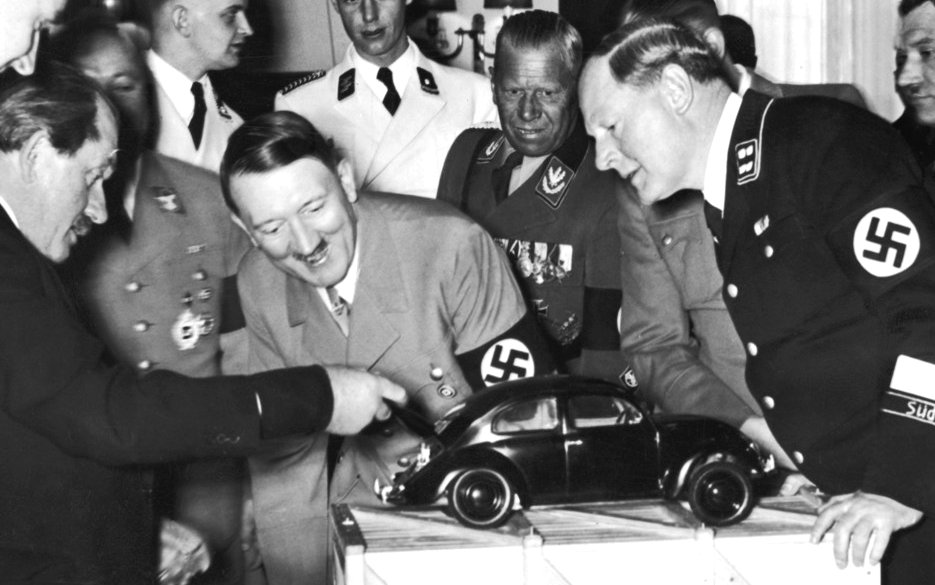
1939 - May 26: Ceremony commemorates laying of cornerstone of VW factory at Wolfsburg, west of Berlin. It would later become world's largest auto factory under one roof. Beetle production halted in favor of wartime production.
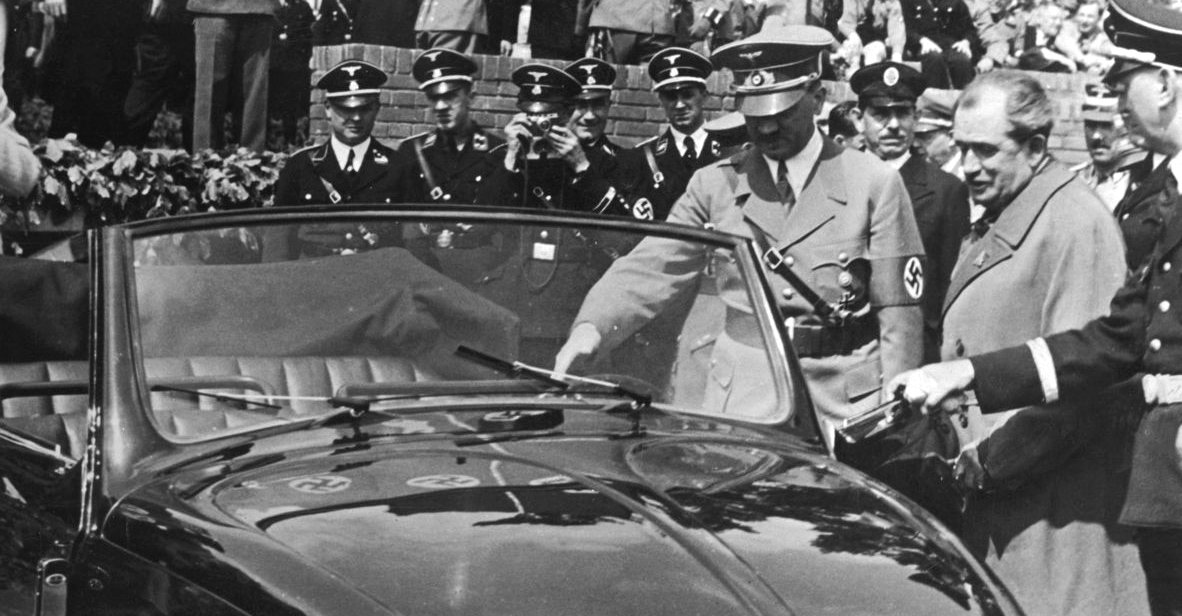
1940 - KdF-Wagen unveiled to public at Berlin Auto Show. Germany goes to war.
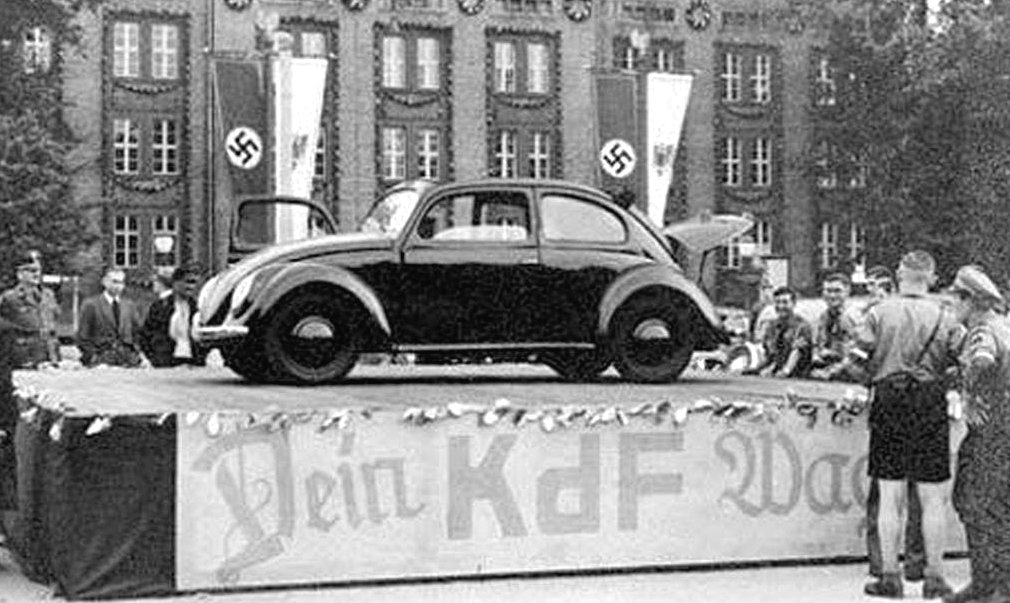
1941 - First four units on display (translation: "The First Manufactured in the Volkswagen Factory")
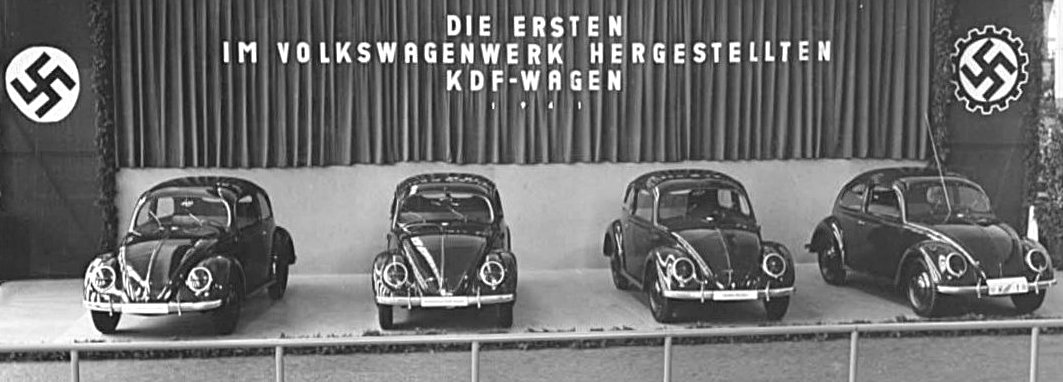
1942 - German army vehicles (Kubelwagens) built; German amphibious army vehicles (Schwimmwagens) built
1944 - Allies bomb Wolfsburg factory
1945 - Hitler's Nazi Germany surrenders to Allies on May 8; World War II ends in Europe. Production of Beetle begins in December 1945. British military helps Volkswagen survive as they push to keep the Wolfsburg factory open. Porsche interrogated by Allies for his connections to Nazis. Is cleared, but later imprisoned in France with son Ferry for two years. And the Beetle absolutely thrived over the subsequent decades.
1946 - 1,785 cars built, mostly by hand; used as Army light transport vehicles
1947 - Wolfsburg plant produces 19,000 cars; all exported to Holland. Two hand-made convertibles built.
1948 - 20,000th Beetle built. Beetle modified into convertible. Henry Ford II given opportunity to buy Volkswagen but declines. 24 years later, VW Beetle out-sells Ford Model-T, becoming one of the world's top selling cars.
1949 - January 17: First Beetle bought in USA by Ben Pon. Max Hoffman becomes first importer.
1950 - 100,000th Beetle built (1,000 were convertibles). Ferdinand Porsche visits Wolfsburg plant; cries when he sees Beetles on the Autobahn--- his dream car has become reality. It is sometime in the 1950s when people start calling it Käfer, German for "Beetle." In France, it would be nicknamed the Coccinelle or "Ladybug." (While many people today still call it a "Bug," the official name is "Beetle.")
1951 - January 10: Ferdinand Porsche dies at age 75.
1952 - First official gathering of Beetle owners. Canada imports its first Beetle.
1953 - 500,000th Beetle built. VW plant opens in Sao Paulo, Brasil.
1954 - December 6: Volkswagenwerk GMBH officially registers "Volkswagen" as a trademark, although the name had been used for many years.
1955 - April: VW of America formed. One-millionth Beetle built.
1957 - Two-millionth Beetle built
1959 - Three-millionth Beetle built
1960 - Four-millionth Beetle built
1961 - Five-millionth Beetle built.
1962 - VW of America headquarters at Englewood Cliffs NJ dedicated. Six-millionth Beetle built.
1963 - Seven-millionth Beetle built
1964 - Eight- and Nine-millionth Beetles built
1965 - Ten-millionth Beetle built
1966 - Eleven- and Twelve-millionth Beetles built. For 1966, new 1300cc 50 hp (37 kW; 51 PS) engine replaces previous 1200cc engine that had been the sole engine since 1954. Models carry a "1300" badge on the engine lid. The 1300cc engine was standard for North America.
1967 - First year Beetles use a 12-volt battery (previous years were 6-volt)
1968 - First year Beetles use plastic dashboards (previous years were all-metal dashboards).
1970 - Super Beetle introduced. Last year convertible Beetle in standard format is available (only convertible Beetles in Super Beetle format are available).
1972 - February 12: 15,007,034th Beetle rolls off assembly line, surpassing Ford Model-T in total production.
1974 - June: The last of 11,916,519 Beetles built at Wolfsburg plant rolls off assembly line.
1975 - Last year for Super Beetle production.
1977 - Last year for standard Beetle in USA; only Super Beetle convertibles remain.
1978 - Last official German-built Beetle rolls off assembly line at Emden (my car was built there in Dec 1965).
1979 - January 10: Last Beetle convertible built
1981 - Twenty-millionth Beetle built (in Puebla, Mexico)
1998 - Production model of New Beetle unveiled at Detroit International Auto Show. Unlike the classic Beetle, the New Beetle's engine is in the front. (Also see 2019.)
1999 - New Beetle Turbo available to US dealerships. Global Automotive Elections Foundation's "Car of the Century" competition chooses Ford Model T as world's most influential car of the 20th century, followed by the Mini, Citroën DS, and VW Beetle.
2003 - July 30: Last Beetle (21,529,464th) rolls off assembly line (in Puebla, Mexico), 63 years after it was unveiled to the public in Nazi Germany in 1940. The last unit was then shipped off to the company's museum in Wolfsburg, Germany. In true Mexican fashion, a mariachi band serenaded the last car. The last Beetle: 13.32 feet long, 5.08 feet wide, 4.92 feet high, 7.87 feet between axles, 1,786 pounds; 4 cylinders, 1.6 Litres; manual transmission; front disc brakes, back drum brakes; 10.57 US gallons fuel capacity; 5 passengers (they should be friends); painted "Aquarius Blue"
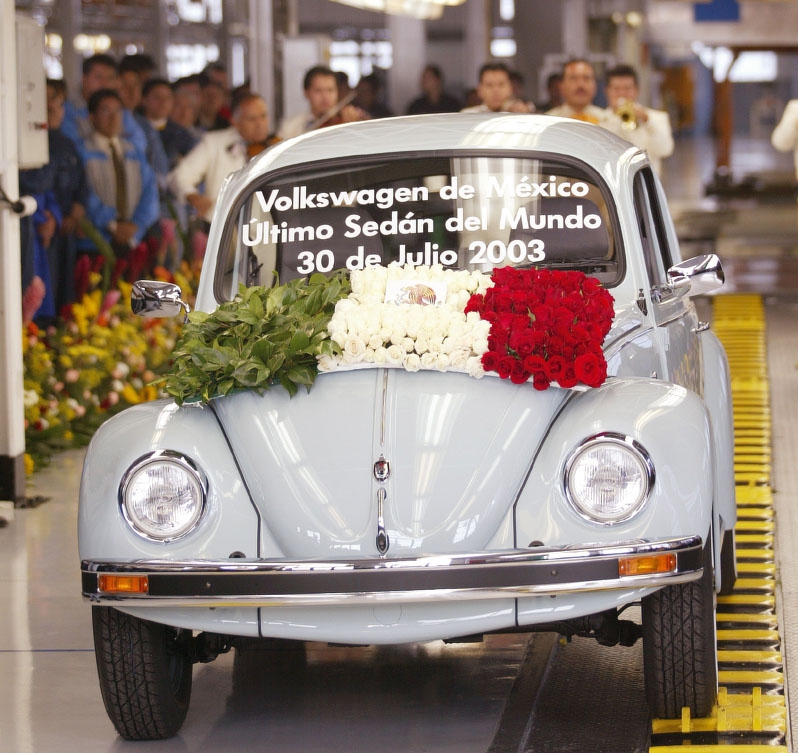
2019 - Last production year for the New Beetle. It is rumored that the Beetle may be resurrected a few years from now as an all-electric car. Stay tuned. Film at 11.

My Collection
|
I am not denying, ignoring, or in any way minimizing the absolute evil of Adolf Hitler and his regime. |
The pin at the top is a replica; the one below is an original. 1" in diameter.
1½" wide
1½" wide. I do not doubt its authenticity. But for $1,500, I think I'm pretty happy with my $20 replica above.
1½" wide, 2½" high.
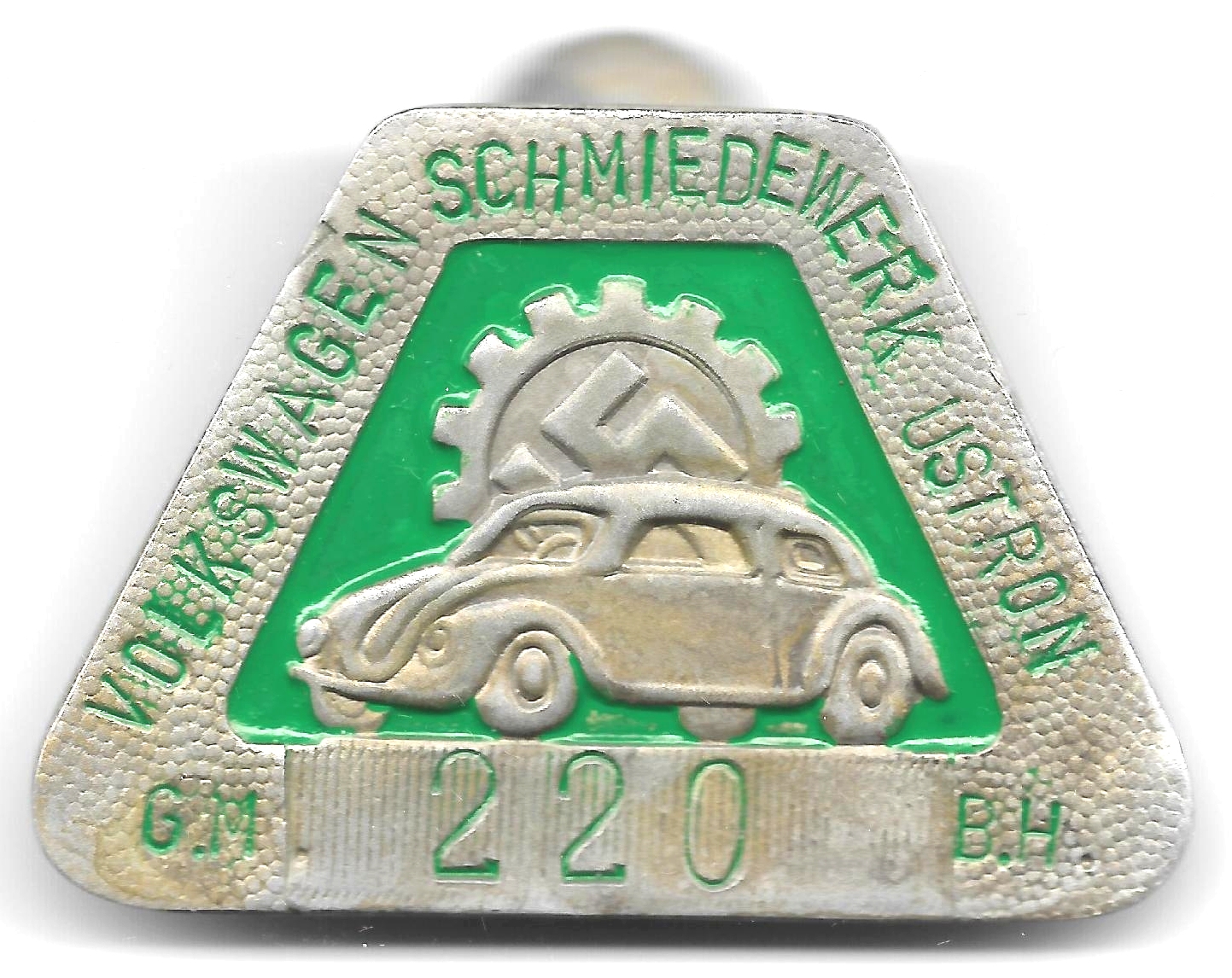
An authentic ID badge worn by some VW factory worker in the early 1940s. It is light-weight, perhaps a heavy tin. "220" might be the worker's unique ID number, or maybe a building number? It appears the round post in the back would slip into a typical button hole on a jacket or apron. I have seen other examples of this badge in blue, orange and red. Perhaps the color of the badge indicated the particular building to which the worker was assigned?
In January 1941, the Vienna-based Schrauben-und Schmiedewaren-Fabriks AG, Brevillier & A. Unger & Söhne became Schmiedewerk Ustron GmbH, based in Berlin (Gmbh is similar to today's LLC, or limited liability company). The plan was to expand the plant into a large-scale forge, capable of supplying the forgings needed for 450,000 VWs annually after the war. However, by the end of 1941, the factory's 687 workers primarily supplied the Reichsbahn (state railways) and the Wehrmacht (Nazi military). The 630 VWs that were produced went to the Nazi elite, none to the common citizen. So much for the "people's car."
This badge is 2¼" wide at the base; just over 1½" tall
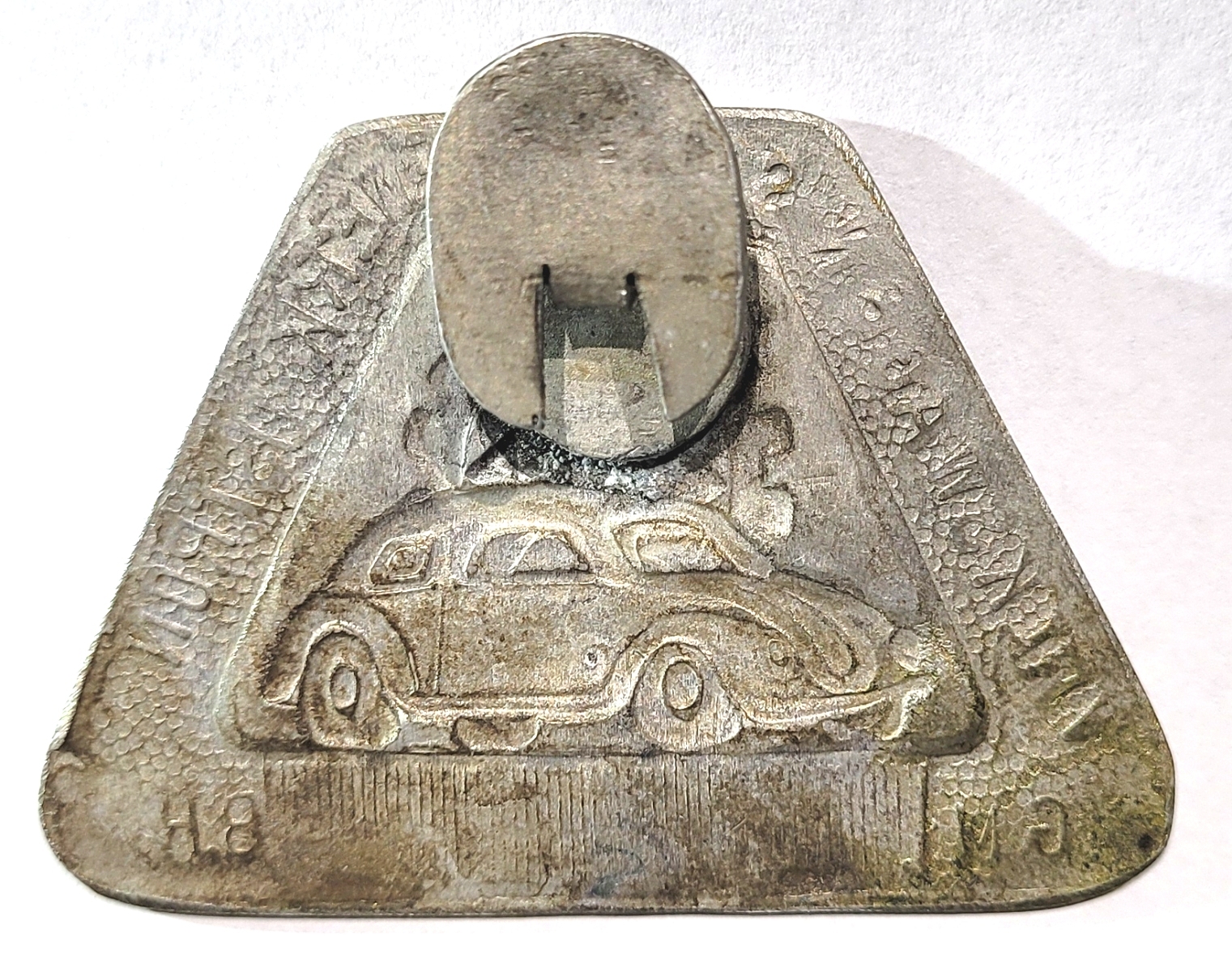
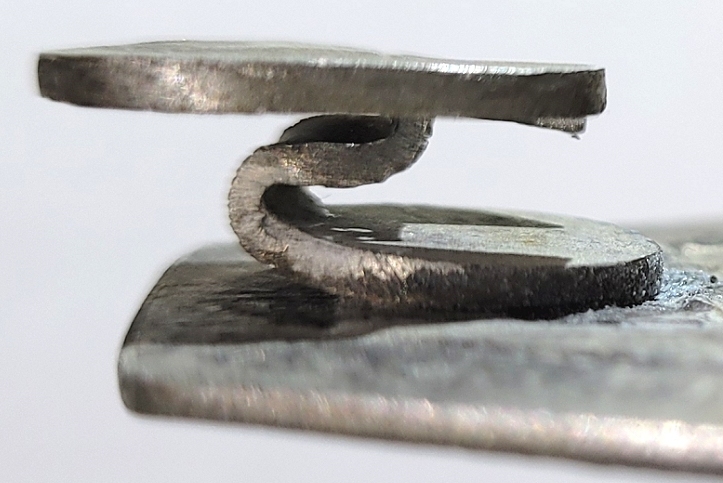
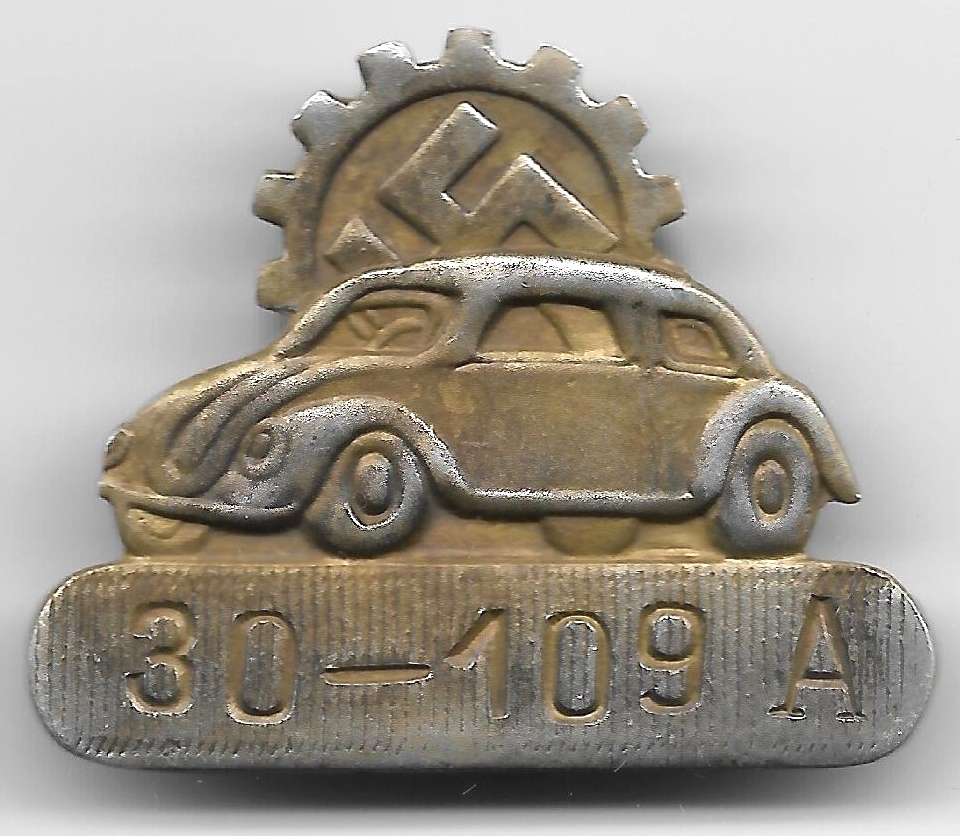
An authentic ID badge worn by some VW factory worker in the early 1940s. It is light-weight, perhaps a heavy tin. "30-109 A" might be the worker's unique ID number, or maybe a building number? It appears the round post in the back would slip into a typical button hole on a jacket or apron. The badge was made by the company H. Aurich in Dresden, Germany. "Ges Gesch" means "registered trademark."
This badge is 1½" wide at the base; 1¼" tall
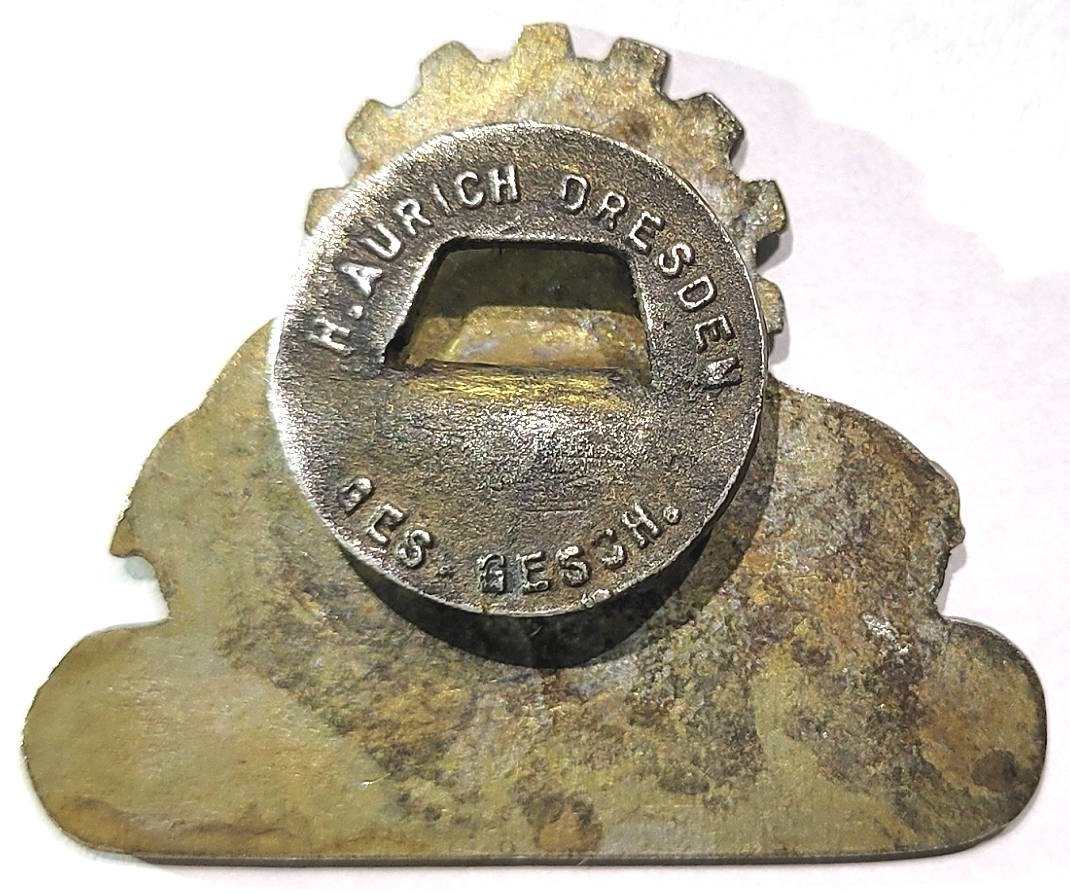
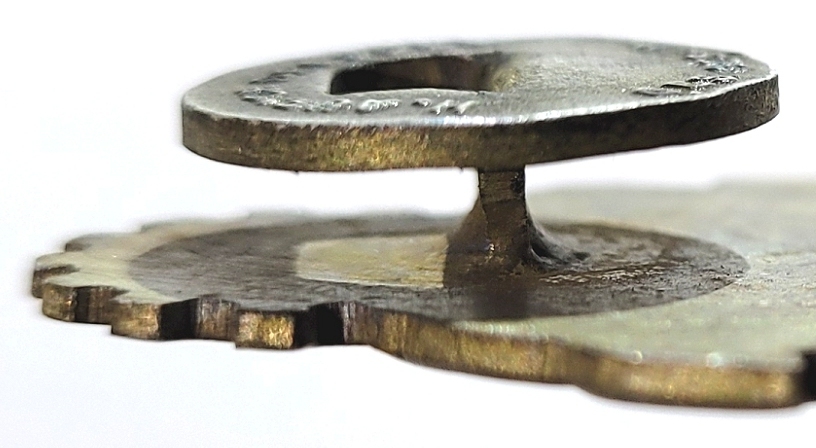
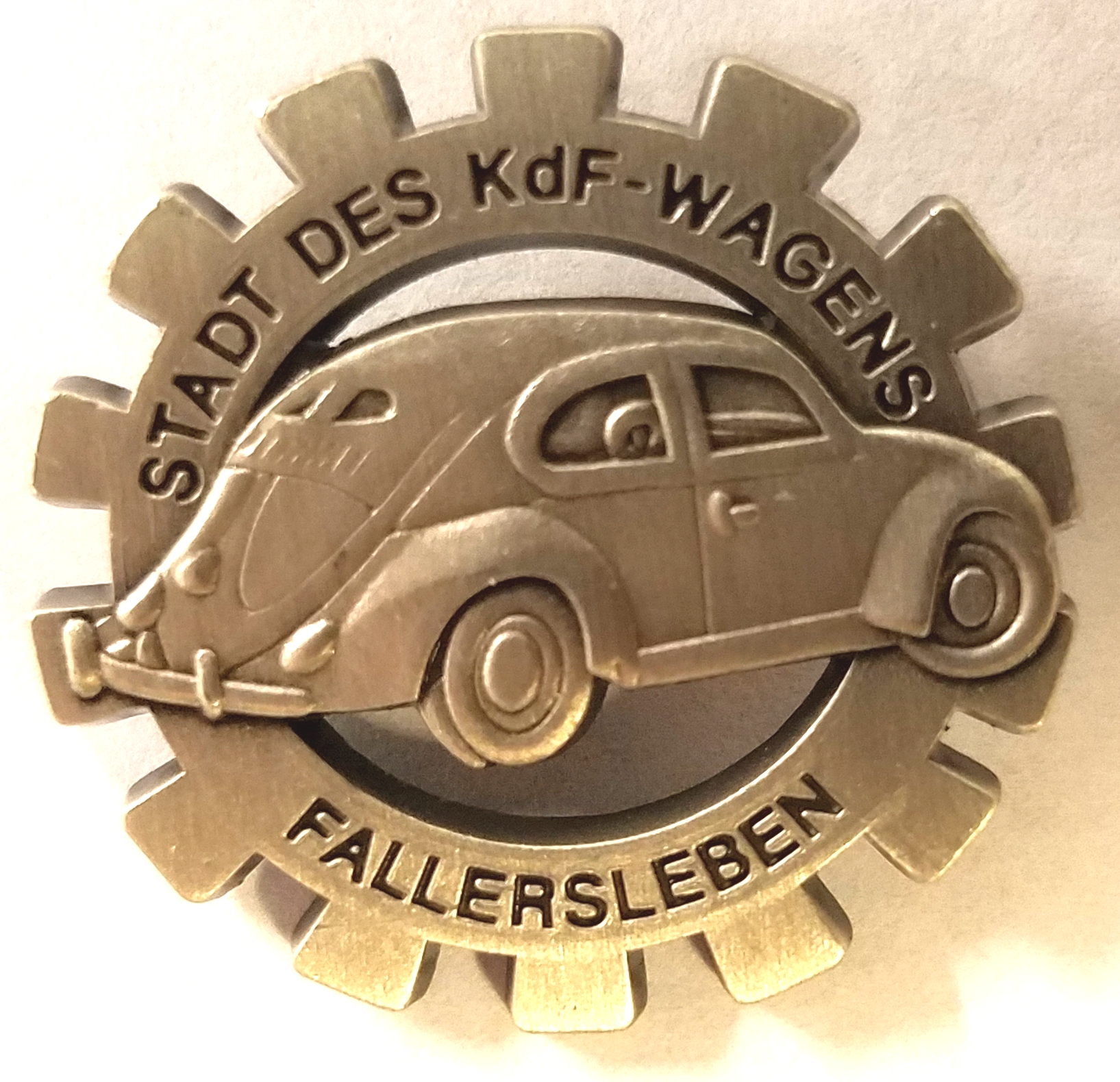
A lapel pin given away at the dedication of the VW factory at Fallersleben (renamed Wolfsburg after WWII) on July 1, 1938. "City of the KdF-Wagens, Fallersleben." Fallersleben was constructed to be the home of the new Volkswagen factory. The facility was dedicated by Adolf Hitler. It was at Fallersleben that the iconic Beetle was born. Fallersleben was renamed Wolfsburg in May 1945, and is now the home to Volkswagen AG. VW Beetle production continued at Wolfsburg through 1978. "Stadt des KdF-Wagens" ("Home of the Volkswagen").
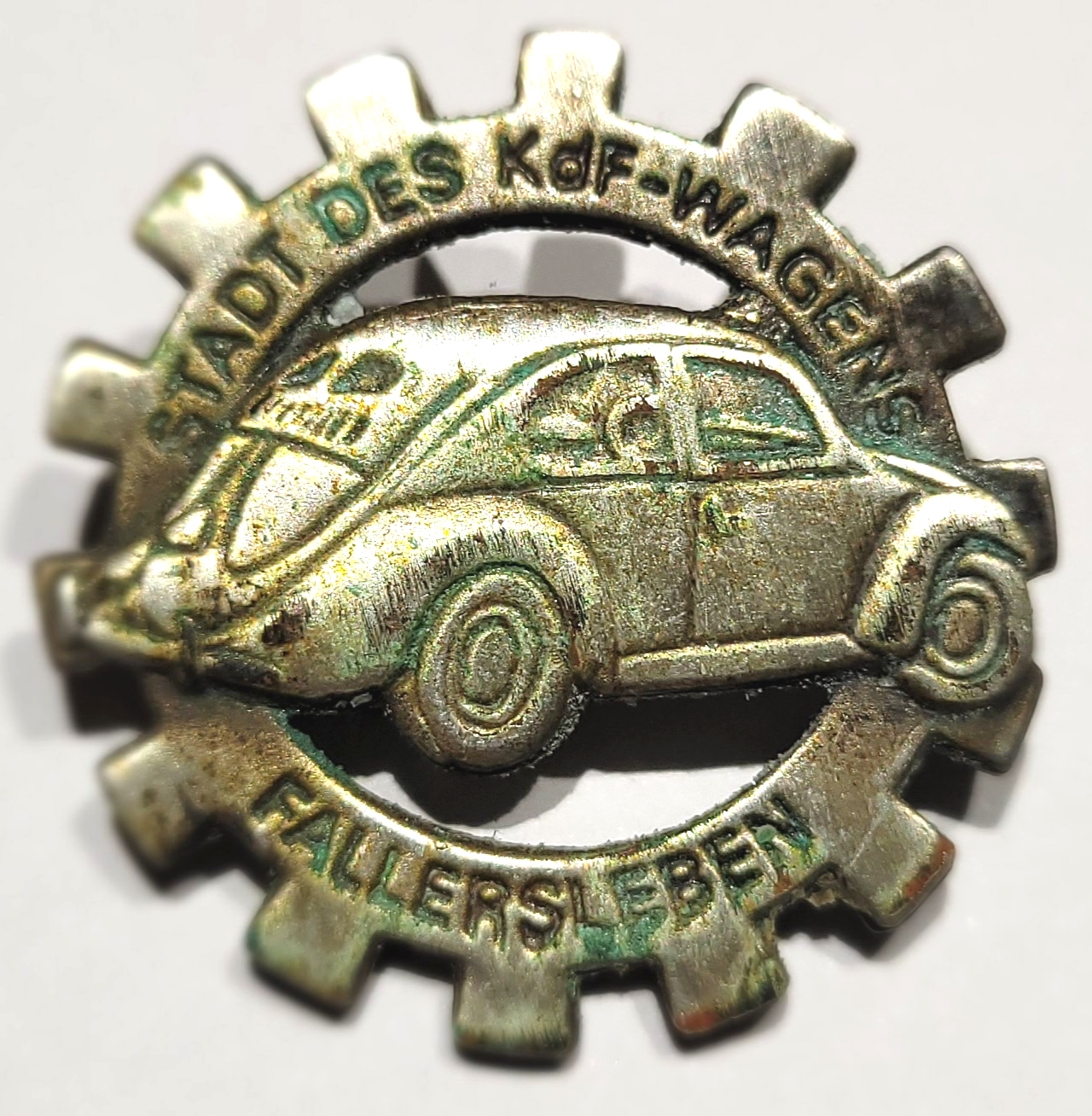
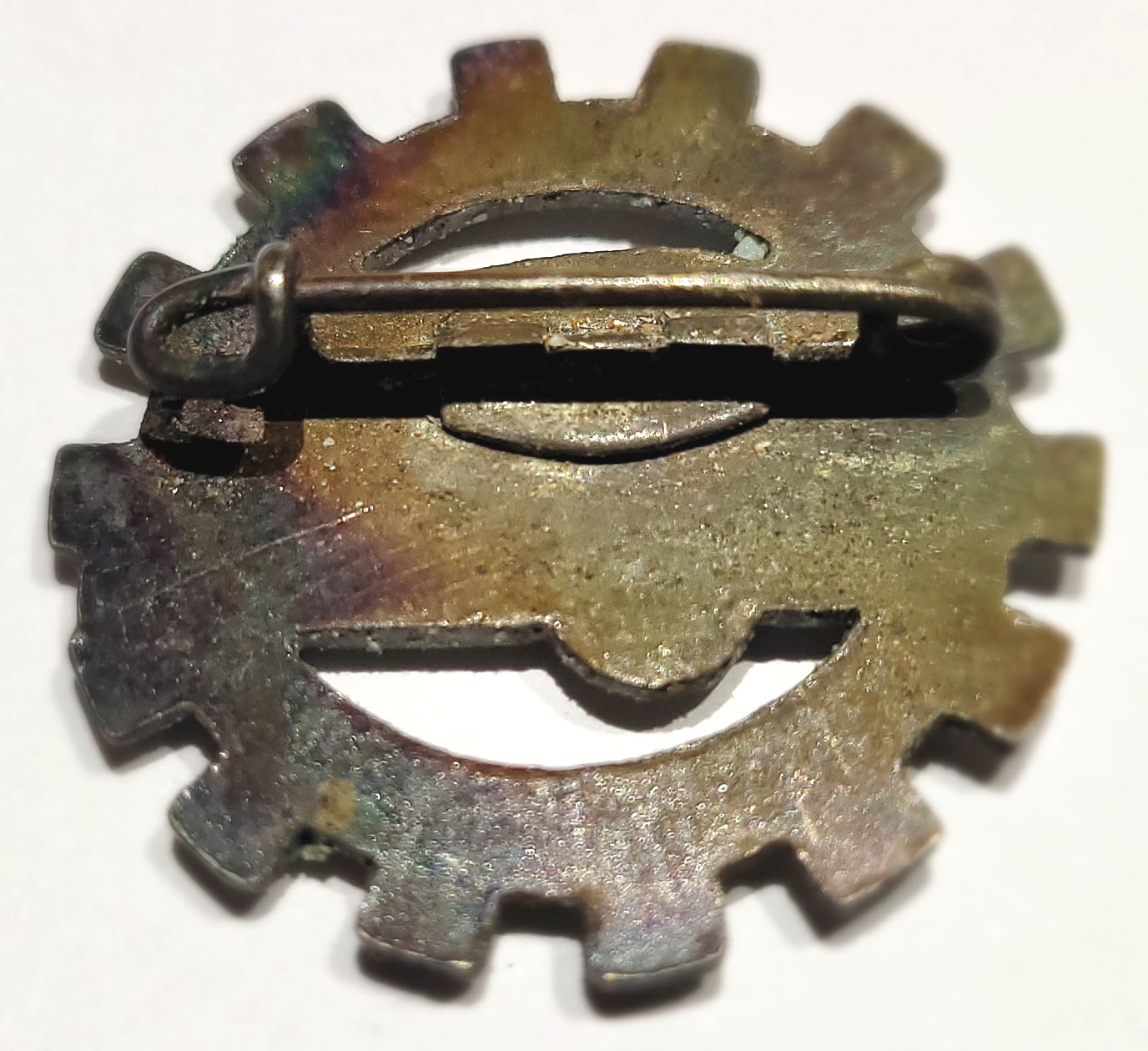
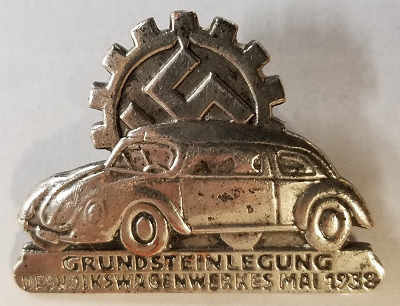
A replica (I am rather certain) of a lapel pin given away at the cornerstone-laying of the VW factory near the 14th century Wolfsburg Castle, west of Berlin, Germany, on May 26, 1938. Adolf Hitler and Dr. Ferdinand Porsche were among the 2,000 guests that day. On display were three VW Type 38 KdF vehicles: a dark blue sedan, a black sunroof sedan and a dark burgundy convertible. The KdF sedan was a split-window Beetle, and would serve as the post-war Volkswagen design for decades to come. The Wolfsburg factory became the world's largest auto factory under one roof. "Laying of the Cornerstone, Volkswagen Factory, May 1938."
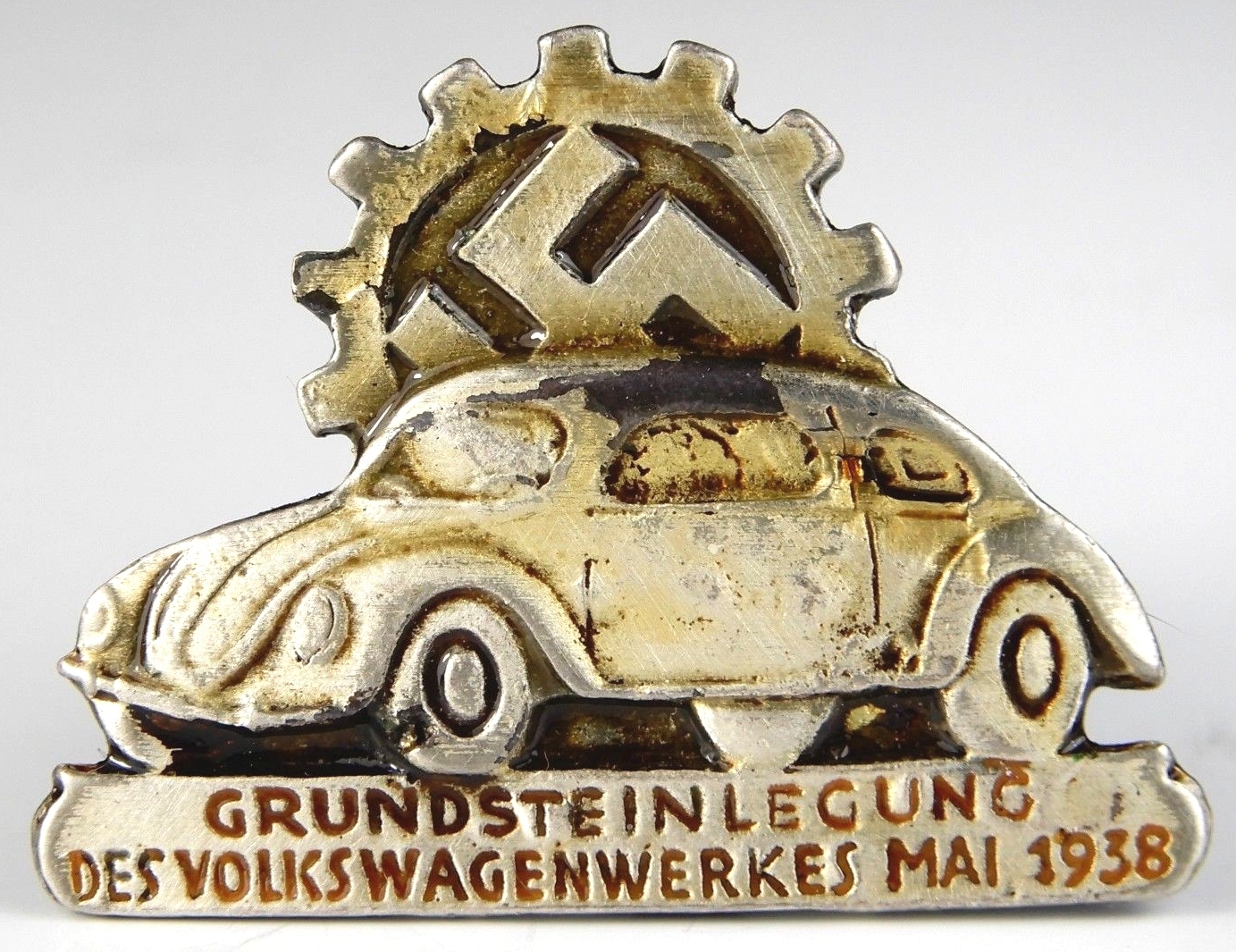
This pin was offered on eBay in June 2018 for $1,500. According to the seller, "Rare piece of automobile history. Heavy metal medal commemorating Hitler's 'people's car.' Original Volkswagen Beetle car with gear. 'Grunsteinlegung des Volkwagenwerks Mai 1938.' Reverse pinback, reads 'RZ GES. GESCH.' Extremely rare piece. The bar pin is missing."
Update: Within days of it being posted on eBay, this item was removed. Hmmmm, interesting.
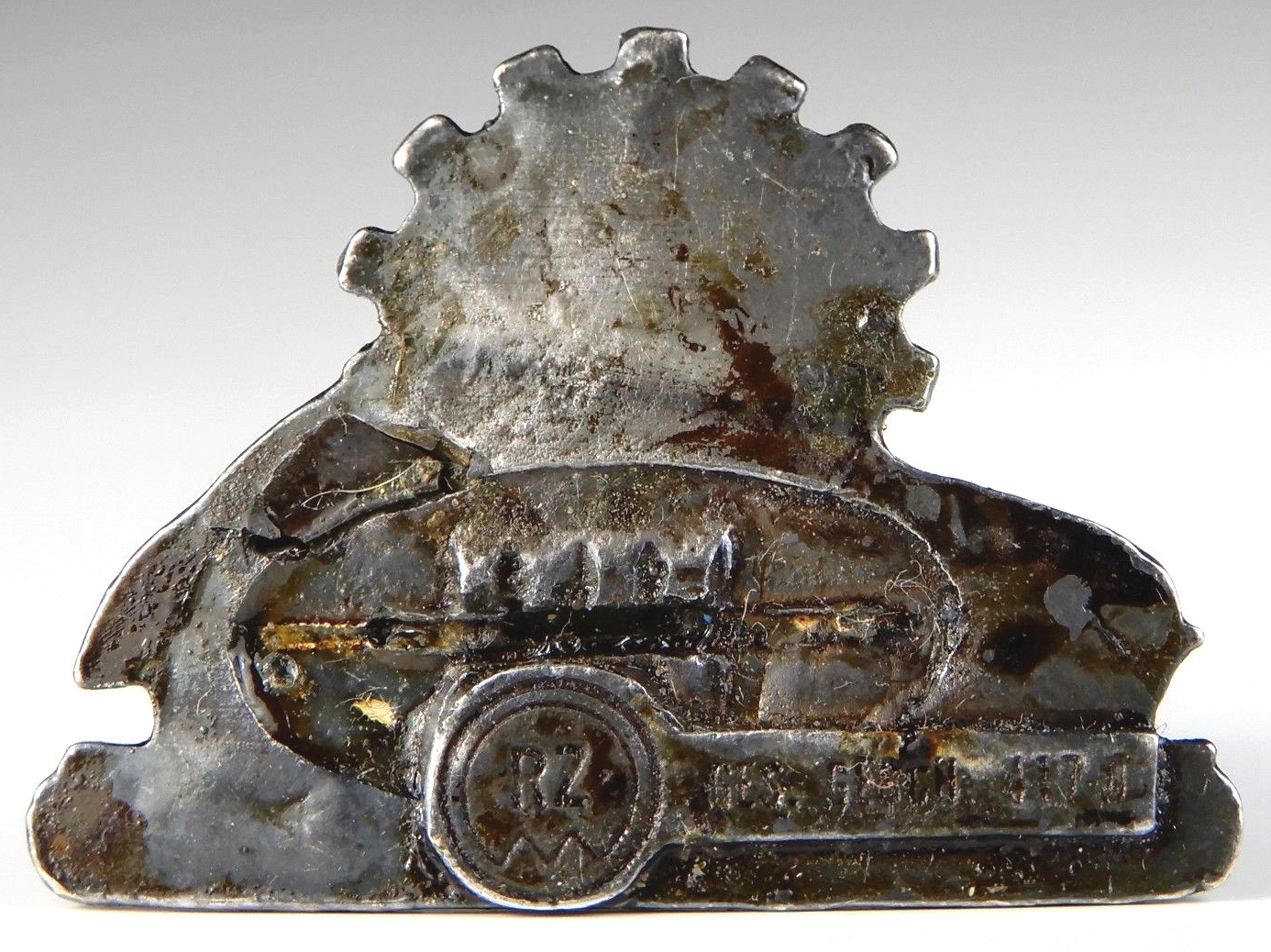
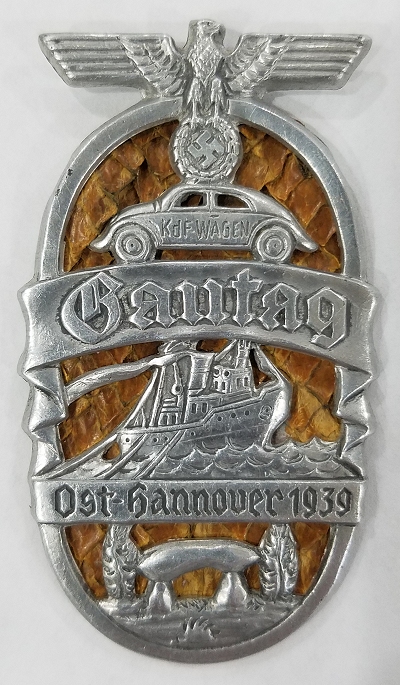
A light-weight die-stamped badge with six crimps on the back, holding a thin layer of waxed cork (the brown you see here is the cork). I think collectors call these type of badges "tinnies." A simple pin glued onto the cork on the back. It was allegedly given to participants of some conference held in East Hannover in 1939. A transportation conference perhaps? I have seen several variations of this badge, with various materials used as backing--- mine is cork. The skeptic in me thinks this pin is a replica. If you know more, please email me. Thank you.
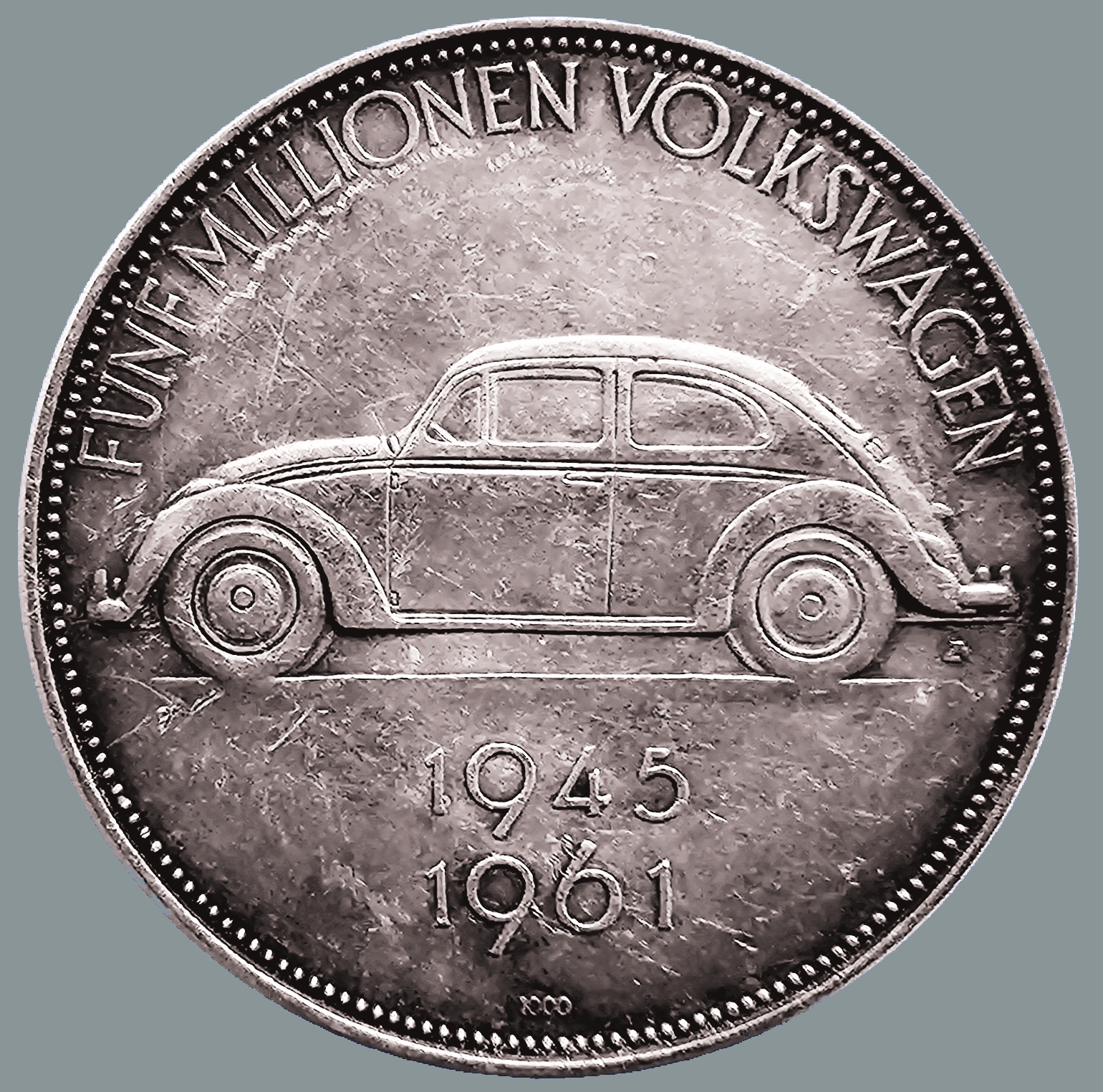
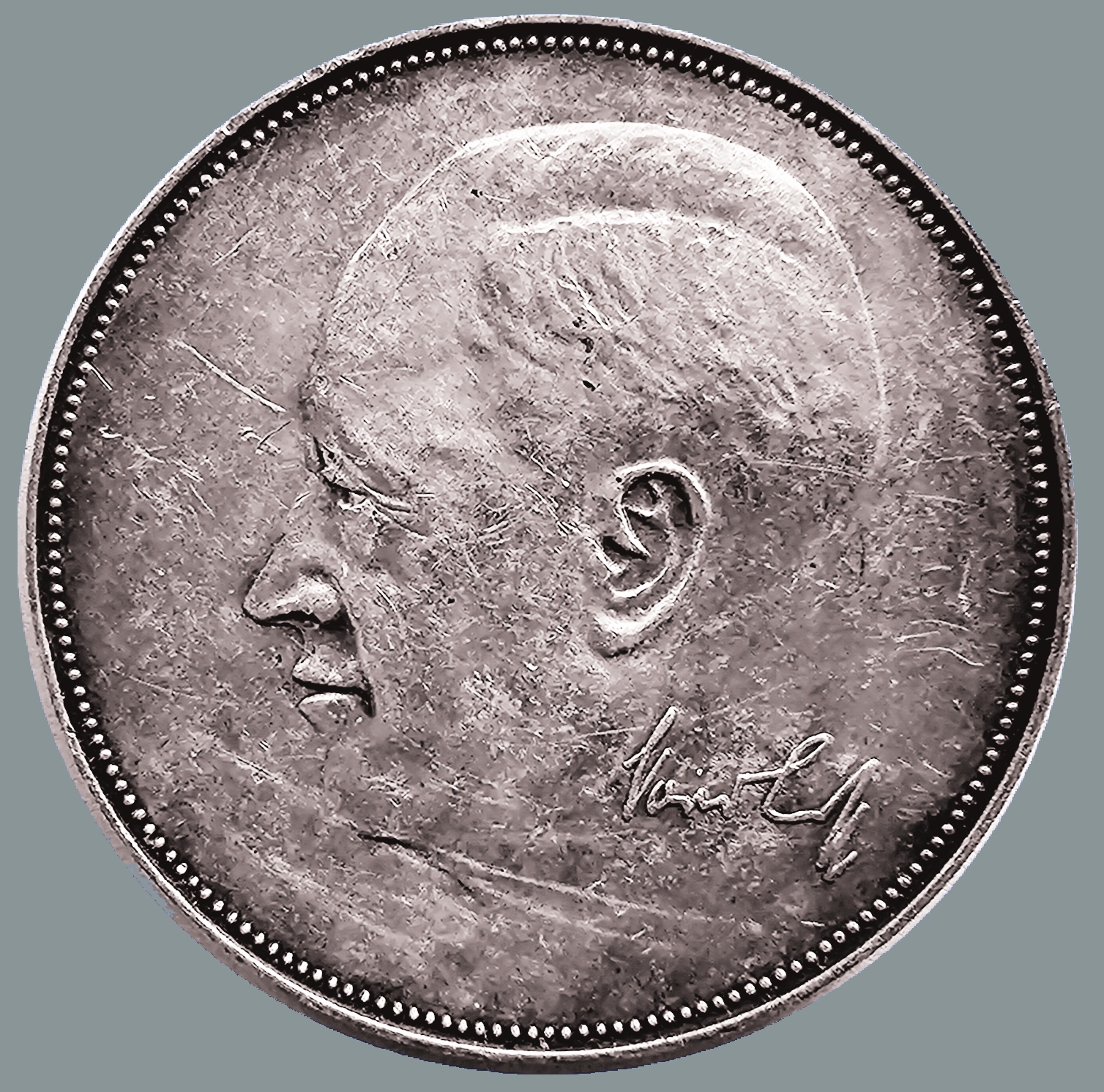
| The medallion above was issued in 1961 to workers at the Wolfsburg Germany Volkswagen factory to commemorate the production of the five-millionth VW Beetle. The medallion bears the image and signature of the legendary Heinz Heinrich Nordhoff (right). Nordhoff was a German engineer who led Volkswagen for 20 years (1948-1968), rebuilding the company after World War II. He turned the VW Beetle into a worldwide automotive phenomenon, producing almost 15 million vehicles. He pioneered the idea of constant improvement while keeping the basic style the same, sort of like, "If it ain't broke, don't fix it." He gave liberal benefits to Volkswagen workers and increased pay scales. Within six years after taking over Volkswagen, Nordhoff reduced the number of man-hours to produce a single car by 75%. His commitment to improving the workmanship at Volkswagen made the Beetle famous for reliability. Medallion is 1½" in diameter, roughly the size and weight of a US silver dollar. Often found on eBay for about $200. I bought this one for WAY less. 😉 |
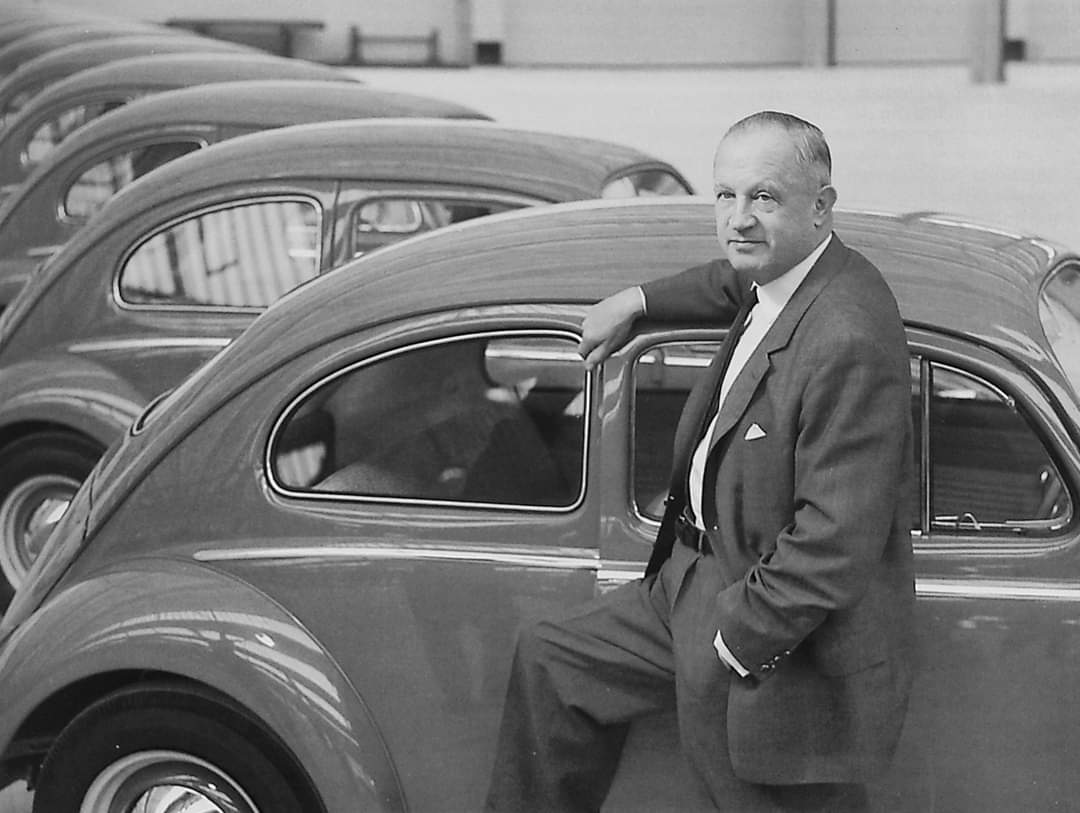
|
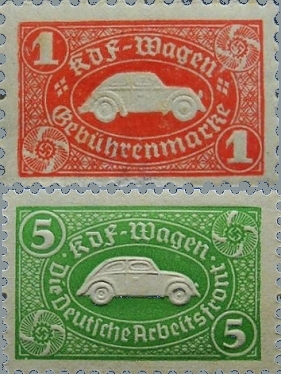
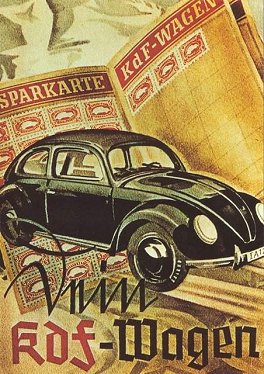
The Nazis told the German citizens they could use a savings book to record payments toward a future KdF-wagen using Revenue Savings stamps, each stamp representing another payment toward their car. The plan to produce an affordable car for all Germans never materialized for anyone except those in the Nazi upper command. I do not know how many of these stamps one would need to purchase a new KdF-Wagen.
Aug 1938 - The DAF (German Labour Front) announces the "KdF-Wagen installment savings plan." The politically-determined purchase price of 990 Reichsmarks (about $2,475 in 1938) can be paid through a weekly minimum installment of five Reichsmarks into a DAF savings plan. By the end of WWII, over 336,000 citizens had signed up for the plan, far fewer than the DAF had expected, and insufficient to fulfil the vision of a mass-motorized society. Moreover, wage-earners are severely under-represented because of their lower than average income (they make about 30 Reichsmarks/week, or roughly $75/week or $3,900/year). By the end of WWII, no KdF-Wagens had been delivered to any of the citizens enrolled in this "savings plan."
1938 KdF-Wagen Brochure
These eight panels are a 1938 brochure intended to impress the German people with the idea of the KdF-Wagen ("Kraft durch Freude" or "Strength through joy"). What was promoted as being an affordable car for the "common German citizen" never materialized for anyone other than Nazi command staff. So much for a "people's car."
My thanks to Seth Emerson who painstakingly translated the German text to English. Some German words used in the 1930s are hardly even known today. Coupled with the elaborately decorative German font Fraktur, translation is not easy. You will see some sections that were simply too difficult to accurately translate. I have noted these with [?]. Thank you for your help, Seth!
[Right side of page]
The highly resistant overhead valve 4-cylinder engine is exceptional in regard to outside temperatures and maintenance, very economical, and is air-cooled, all without special preventative measures other than garage storage during winter. The 4-speed transmission allows for great use in any terrain and a maximum driving experience on the Federal Autobahn, particularly due to the radiator cooling system.
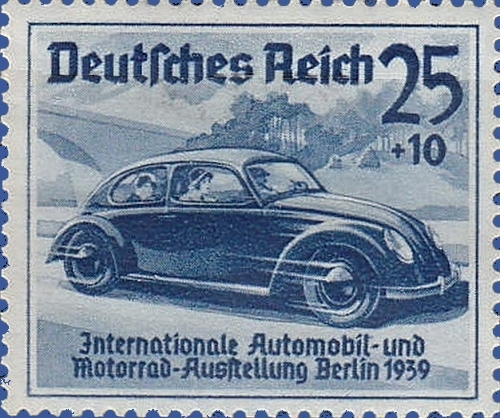
A postage stamp from the 1939 Auto Exposition in Berlin, Germany. Artist's rendering of a KdF-wagen.
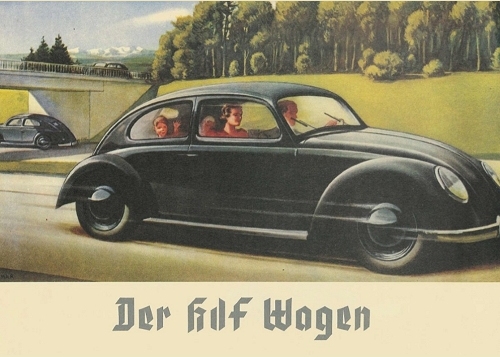
<<
The KDF Wagen ["Kraft durch Freude" or "Strength through joy" car]
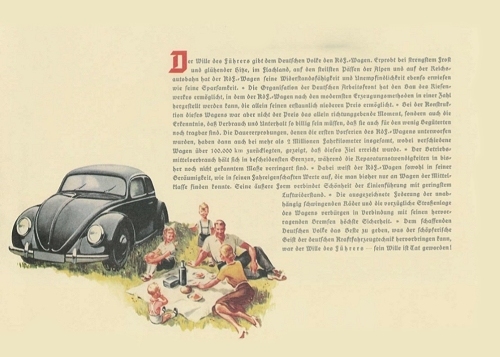
<<
The will of the Fuehrer [Adolf Hitler] presents the German people with the KDF Wagen ["Kraft durch Freude" or "Strength through joy" wagon]. Tried and tested by the strongest [?], in the flat lands, along the steepest passes in the Alps, and on the Federal Autobahn, the KDF Wagen has great resistance and durability as well as proven to be economical. The German Labor Front has made the mass production of this "great-deal" possible by using the most modern technology, all for an amazingly low price. But the price of the construction of these automobiles is not the defining factor. Additionally it is the knowledge that the consumption and maintenance can be so cheap and can be affordable for those who with little means. The endurance tests, [?], have undergone altogether more than two million kilometers of driving, whereupon each car has covered a distance of over 100,000 km, demonstrates, that this goal was reached. The use of operating costs has been kept to the lowest minimum, while the necessity to maintain [?]. The KDF Wagen is also nicely spacious, and has a smooth ride quality, which until now could only be found in mid-sized automobiles. Its exterior combines a beautiful line of layout with minimum air resistance. The excellent suspension with independent rotating wheels and incredible road-handling of this car, works in conjunction with the highest security braking. It is the will of the Fuehrer for the industrious German people to do their best, which has been clearly demonstrated by the creative spirit of the German automotive industry. What a will it has become!
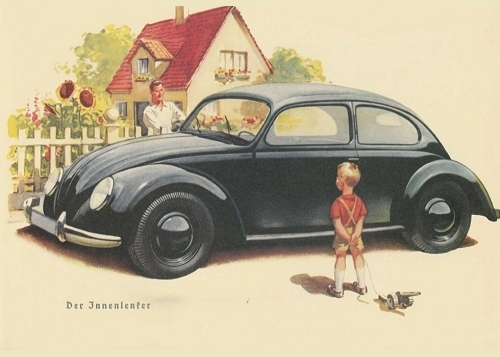
<<
[?]
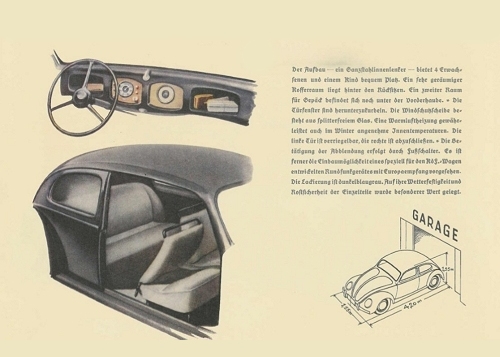
<<
The design offers space to comfortably seat four adults and one child. A very spacious trunk is located behind the backseat. A second space for luggage can be found under the front hood. The door window [?]. The windshield is made from shatterproof glass. A warm-air heating system provides a comfortable interior-temperature in winter. The left door is lockable, the right can be closed. The headlight dimmer switch is operated through the foot pedal. Furthermore, exclusively developed for the KDF Wagen, additional installation of a radio with European reception is available. The paint is dark-blue gray. As an extra value, individual parts have been used for weather resistance and to prevent rust.
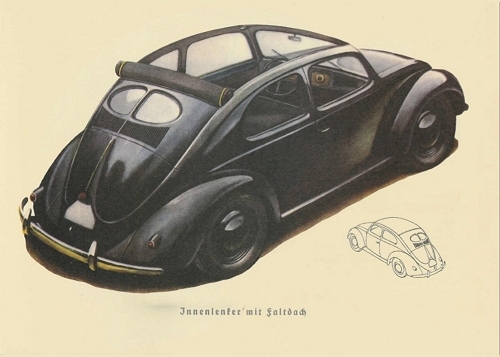
<<
With sunroof
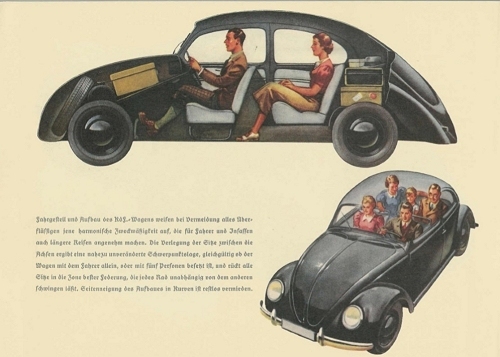
<<
The chassis and body have been widened to make the KDF Wagen more spacious, which makes longer trips more pleasant. The seats that are positioned between the axles create a nearly unaltered center of gravity, regardless of whether the driver is alone or the car is full with five persons, and moves all the seats in the zone of best suspension, which allows each wheel to rotate independently. Swaying in curves is completely eliminated.
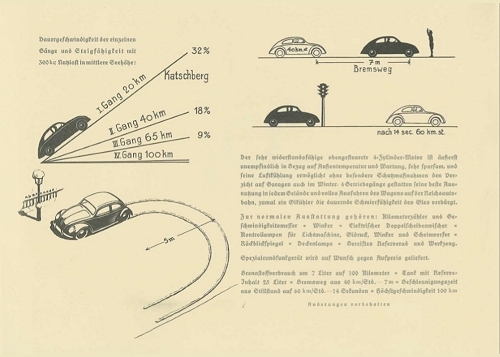
<< [Left side of page]
Cruising speed at each gear and climbing ability with 300Kg of cargo at average sea level.
Tested in Katschberg (Mountain pass in the Austrian Alps. Elevation is 5,384 ft)
1st Gear 20km/hr 32% gradient
2nd Gear 40km/hr 18% gradient
3rd Gear 65km/hr 9% gradient
4th Gear 100Km/hr
40km/hr 7m braking distance
0-60km/hr in 14 seconds
Standard equipment includes: Odometer and Speedometer. Directional indicator (turn signal). Electric dual-windshield wipers. Indicator lamps (lights) for generator, oil pressure, windshield wipers and headlights. Rear-view mirror. Interior light. Spare-tire and toolkit.
Special five-speed transmission vehicles are available at an extra charge.
Fuel consumption is 7 liters for 100km. Fuel tank with reserve holds 25 liters. Braking distance at 40km/hr is 7 meters. 0-60km/hr in 14 seconds. Maximum speed is 100km/hr
*Subject to changes
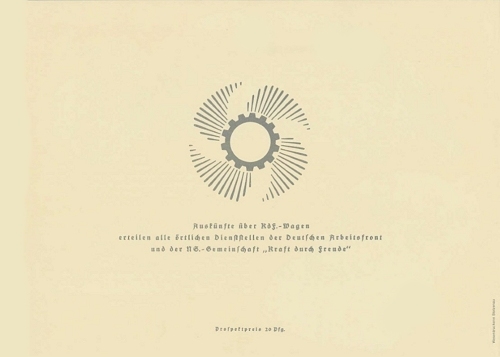
<< Details about the KDF Wagen are available at all local departments of the German Labor Front and the Nazi-Community. "Speed Through Joy"

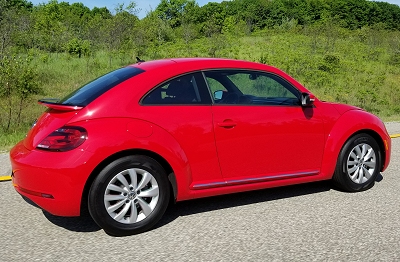
|
In June 2020, I delivered a new 2019 Beetle Turbo for a local VW dealership to a happy customer in Ludington MI. It was Tornado Red. The salesman who sold the car to this customer told me it was last Beetle available in Michigan. The salesman and I chuckled about the color name. I would have thought "Tornado" would more appropriately describe a shade of black or dark gray. Maybe the person who initially called it Tornado Red meant Tomato Red? ha ha |

